- 2018/03/18/Making-a-presentation-from-your-research-proposal

Making a presentation from your research proposal
In theory, it couldn’t be easier to take your written research proposal and turn it into a presentation. Many people find presenting ideas easier than writing about them as writing is inherently difficult. On the other hand, standing up in front of a room of strangers, or worse those you know, is also a bewildering task. Essentially, you have a story to tell, but does not mean you are story telling. It means that your presentation will require you to talk continuously for your alloted period of time, and that the sentences must follow on from each other in a logical narative; i.e. a story.
So where do you start?
Here are some simple rules to help guide you to build your presentation:
- One slide per minute: However many minutes you have to present, that’s your total number of slides. Don’t be tempted to slip in more.
- Keep the format clear: There are lots of templates available to use, but you’d do best to keep your presentation very clean and simple.
- Be careful with animations: You can build your slide with animations (by adding images, words or graphics). But do not flash, bounce, rotate or roll. No animated little clipart characters. No goofy cartoons – they’ll be too small for the audience to read. No sounds (unless you are talking about sounds). Your audience has seen it all before, and that’s not what they’ve come for. They have come to hear about your research proposal.
- Don’t be a comedian: Everyone appreciates that occasional light-hearted comment, but it is not stand-up. If you feel that you must make a joke, make only one and be ready to push on when no-one reacts. Sarcasm simply won’t be understood by the majority of your audience, so don’t bother: unless you’re a witless Brit who can’t string three or more sentences together without.
Keep to your written proposal formula
- You need a title slide (with your name, that of your advisor & institution)
- that put your study into the big picture
- explain variables in the context of existing literature
- explain the relevance of your study organisms
- give the context of your own study
- Your aims & hypotheses
- Images of apparatus or diagrams of how apparatus are supposed to work. If you can’t find anything, draw it simply yourself.
- Your methods can be abbreviated. For example, you can tell the audience that you will measure your organism, but you don’t need to provide a slide of the callipers or balance (unless these are the major measurements you need).
- Analyses are important. Make sure that you understand how they work, otherwise you won’t be able to present them to others. Importantly, explain where each of the variables that you introduced, and explained how to measure, fit into the analyses. There shouldn’t be anything new or unexpected that pops up here.
- I like to see what the results might look like, even if you have to draw graphs with your own lines on it. Use arrows to show predictions under different assumptions.
Slide layout
- Your aim is to have your audience listen to you, and only look at the slides when you indicate their relevance.
- You’d be better off having a presentation without words, then your audience will listen instead of trying to read. As long as they are reading, they aren't listening. Really try to limit the words you have on any single slide (<30). Don’t have full sentences, but write just enough to remind you of what to say and so that your audience can follow when you are moving from point to point.
- Use bullet pointed lists if you have several points to make (Font 28 pt)
- If you only have words on a slide, then add a picture that will help illustrate your point. This is especially useful to illustrate your organism. At the same time, don’t have anything on a slide that has no meaning or relevance. Make sure that any illustration is large enough for your audience to see and understand what it is that you are trying to show.
- Everything on your slide must be mentioned in your presentation, so remove anything that becomes irrelevant to your story when you practice.
- Tables: you are unlikely to have large complex tables in a presentation, but presenting raw data or small words in a table is a way to lose your audience. Make your point in another way.
- Use citations (these can go in smaller font 20 pt). I like to cut out the title & authors of the paper from the pdf and show it on the slide.
- If you can, have some banner that states where you are in your presentation (e.g. Methods, or 5 of 13). It helps members of the audience who might have been daydreaming.
Practice, practice, practice
- It can’t be said enough that you must practice your presentation. Do it in front of a mirror in your bathroom. In front of your friends. It's the best way of making sure you'll do a good job.
- If you can't remember what you need to say, write flash cards with prompts. Include the text on your slide and expand. When you learn what’s on the cards, relate it to what’s on the slide so that you can look at the slides and get enough hints on what to say. Don’t bring flashcards with you to your talk. Instead be confident enough that you know them front to back and back to front.
- Practice with a pointer and slide advancer (or whatever you will use in the presentation). You should be pointing out to your audience what you have on your slides; use the pointer to do this.
- Avoid taking anything with you that you might fiddle with.
Maybe I've got it all wrong?
There are some things that I still need to learn about presentations. Have a look at the following video and see what you think. There are some really good points made here, and I think I should update my example slides to reflect these ideas. I especially like the use of contrast to focus attention.


Princeton Correspondents on Undergraduate Research
How to Make a Successful Research Presentation
Turning a research paper into a visual presentation is difficult; there are pitfalls, and navigating the path to a brief, informative presentation takes time and practice. As a TA for GEO/WRI 201: Methods in Data Analysis & Scientific Writing this past fall, I saw how this process works from an instructor’s standpoint. I’ve presented my own research before, but helping others present theirs taught me a bit more about the process. Here are some tips I learned that may help you with your next research presentation:
More is more
In general, your presentation will always benefit from more practice, more feedback, and more revision. By practicing in front of friends, you can get comfortable with presenting your work while receiving feedback. It is hard to know how to revise your presentation if you never practice. If you are presenting to a general audience, getting feedback from someone outside of your discipline is crucial. Terms and ideas that seem intuitive to you may be completely foreign to someone else, and your well-crafted presentation could fall flat.
Less is more
Limit the scope of your presentation, the number of slides, and the text on each slide. In my experience, text works well for organizing slides, orienting the audience to key terms, and annotating important figures–not for explaining complex ideas. Having fewer slides is usually better as well. In general, about one slide per minute of presentation is an appropriate budget. Too many slides is usually a sign that your topic is too broad.

Limit the scope of your presentation
Don’t present your paper. Presentations are usually around 10 min long. You will not have time to explain all of the research you did in a semester (or a year!) in such a short span of time. Instead, focus on the highlight(s). Identify a single compelling research question which your work addressed, and craft a succinct but complete narrative around it.
You will not have time to explain all of the research you did. Instead, focus on the highlights. Identify a single compelling research question which your work addressed, and craft a succinct but complete narrative around it.
Craft a compelling research narrative
After identifying the focused research question, walk your audience through your research as if it were a story. Presentations with strong narrative arcs are clear, captivating, and compelling.
- Introduction (exposition — rising action)
Orient the audience and draw them in by demonstrating the relevance and importance of your research story with strong global motive. Provide them with the necessary vocabulary and background knowledge to understand the plot of your story. Introduce the key studies (characters) relevant in your story and build tension and conflict with scholarly and data motive. By the end of your introduction, your audience should clearly understand your research question and be dying to know how you resolve the tension built through motive.

- Methods (rising action)
The methods section should transition smoothly and logically from the introduction. Beware of presenting your methods in a boring, arc-killing, ‘this is what I did.’ Focus on the details that set your story apart from the stories other people have already told. Keep the audience interested by clearly motivating your decisions based on your original research question or the tension built in your introduction.
- Results (climax)
Less is usually more here. Only present results which are clearly related to the focused research question you are presenting. Make sure you explain the results clearly so that your audience understands what your research found. This is the peak of tension in your narrative arc, so don’t undercut it by quickly clicking through to your discussion.
- Discussion (falling action)
By now your audience should be dying for a satisfying resolution. Here is where you contextualize your results and begin resolving the tension between past research. Be thorough. If you have too many conflicts left unresolved, or you don’t have enough time to present all of the resolutions, you probably need to further narrow the scope of your presentation.
- Conclusion (denouement)
Return back to your initial research question and motive, resolving any final conflicts and tying up loose ends. Leave the audience with a clear resolution of your focus research question, and use unresolved tension to set up potential sequels (i.e. further research).
Use your medium to enhance the narrative
Visual presentations should be dominated by clear, intentional graphics. Subtle animation in key moments (usually during the results or discussion) can add drama to the narrative arc and make conflict resolutions more satisfying. You are narrating a story written in images, videos, cartoons, and graphs. While your paper is mostly text, with graphics to highlight crucial points, your slides should be the opposite. Adapting to the new medium may require you to create or acquire far more graphics than you included in your paper, but it is necessary to create an engaging presentation.
The most important thing you can do for your presentation is to practice and revise. Bother your friends, your roommates, TAs–anybody who will sit down and listen to your work. Beyond that, think about presentations you have found compelling and try to incorporate some of those elements into your own. Remember you want your work to be comprehensible; you aren’t creating experts in 10 minutes. Above all, try to stay passionate about what you did and why. You put the time in, so show your audience that it’s worth it.
For more insight into research presentations, check out these past PCUR posts written by Emma and Ellie .
— Alec Getraer, Natural Sciences Correspondent
Share this:
- Share on Tumblr

Home Blog Presentation Ideas How to Create and Deliver a Research Presentation
How to Create and Deliver a Research Presentation

Every research endeavor ends up with the communication of its findings. Graduate-level research culminates in a thesis defense , while many academic and scientific disciplines are published in peer-reviewed journals. In a business context, PowerPoint research presentation is the default format for reporting the findings to stakeholders.
Condensing months of work into a few slides can prove to be challenging. It requires particular skills to create and deliver a research presentation that promotes informed decisions and drives long-term projects forward.
Table of Contents
What is a Research Presentation
Key slides for creating a research presentation, tips when delivering a research presentation, how to present sources in a research presentation, recommended templates to create a research presentation.
A research presentation is the communication of research findings, typically delivered to an audience of peers, colleagues, students, or professionals. In the academe, it is meant to showcase the importance of the research paper , state the findings and the analysis of those findings, and seek feedback that could further the research.
The presentation of research becomes even more critical in the business world as the insights derived from it are the basis of strategic decisions of organizations. Information from this type of report can aid companies in maximizing the sales and profit of their business. Major projects such as research and development (R&D) in a new field, the launch of a new product or service, or even corporate social responsibility (CSR) initiatives will require the presentation of research findings to prove their feasibility.
Market research and technical research are examples of business-type research presentations you will commonly encounter.
In this article, we’ve compiled all the essential tips, including some examples and templates, to get you started with creating and delivering a stellar research presentation tailored specifically for the business context.
Various research suggests that the average attention span of adults during presentations is around 20 minutes, with a notable drop in an engagement at the 10-minute mark . Beyond that, you might see your audience doing other things.
How can you avoid such a mistake? The answer lies in the adage “keep it simple, stupid” or KISS. We don’t mean dumbing down your content but rather presenting it in a way that is easily digestible and accessible to your audience. One way you can do this is by organizing your research presentation using a clear structure.
Here are the slides you should prioritize when creating your research presentation PowerPoint.
1. Title Page
The title page is the first thing your audience will see during your presentation, so put extra effort into it to make an impression. Of course, writing presentation titles and title pages will vary depending on the type of presentation you are to deliver. In the case of a research presentation, you want a formal and academic-sounding one. It should include:
- The full title of the report
- The date of the report
- The name of the researchers or department in charge of the report
- The name of the organization for which the presentation is intended
When writing the title of your research presentation, it should reflect the topic and objective of the report. Focus only on the subject and avoid adding redundant phrases like “A research on” or “A study on.” However, you may use phrases like “Market Analysis” or “Feasibility Study” because they help identify the purpose of the presentation. Doing so also serves a long-term purpose for the filing and later retrieving of the document.
Here’s a sample title page for a hypothetical market research presentation from Gillette .

2. Executive Summary Slide
The executive summary marks the beginning of the body of the presentation, briefly summarizing the key discussion points of the research. Specifically, the summary may state the following:
- The purpose of the investigation and its significance within the organization’s goals
- The methods used for the investigation
- The major findings of the investigation
- The conclusions and recommendations after the investigation
Although the executive summary encompasses the entry of the research presentation, it should not dive into all the details of the work on which the findings, conclusions, and recommendations were based. Creating the executive summary requires a focus on clarity and brevity, especially when translating it to a PowerPoint document where space is limited.
Each point should be presented in a clear and visually engaging manner to capture the audience’s attention and set the stage for the rest of the presentation. Use visuals, bullet points, and minimal text to convey information efficiently.

3. Introduction/ Project Description Slides
In this section, your goal is to provide your audience with the information that will help them understand the details of the presentation. Provide a detailed description of the project, including its goals, objectives, scope, and methods for gathering and analyzing data.
You want to answer these fundamental questions:
- What specific questions are you trying to answer, problems you aim to solve, or opportunities you seek to explore?
- Why is this project important, and what prompted it?
- What are the boundaries of your research or initiative?
- How were the data gathered?
Important: The introduction should exclude specific findings, conclusions, and recommendations.

4. Data Presentation and Analyses Slides
This is the longest section of a research presentation, as you’ll present the data you’ve gathered and provide a thorough analysis of that data to draw meaningful conclusions. The format and components of this section can vary widely, tailored to the specific nature of your research.
For example, if you are doing market research, you may include the market potential estimate, competitor analysis, and pricing analysis. These elements will help your organization determine the actual viability of a market opportunity.
Visual aids like charts, graphs, tables, and diagrams are potent tools to convey your key findings effectively. These materials may be numbered and sequenced (Figure 1, Figure 2, and so forth), accompanied by text to make sense of the insights.

5. Conclusions
The conclusion of a research presentation is where you pull together the ideas derived from your data presentation and analyses in light of the purpose of the research. For example, if the objective is to assess the market of a new product, the conclusion should determine the requirements of the market in question and tell whether there is a product-market fit.
Designing your conclusion slide should be straightforward and focused on conveying the key takeaways from your research. Keep the text concise and to the point. Present it in bullet points or numbered lists to make the content easily scannable.

6. Recommendations
The findings of your research might reveal elements that may not align with your initial vision or expectations. These deviations are addressed in the recommendations section of your presentation, which outlines the best course of action based on the result of the research.
What emerging markets should we target next? Do we need to rethink our pricing strategies? Which professionals should we hire for this special project? — these are some of the questions that may arise when coming up with this part of the research.
Recommendations may be combined with the conclusion, but presenting them separately to reinforce their urgency. In the end, the decision-makers in the organization or your clients will make the final call on whether to accept or decline the recommendations.

7. Questions Slide
Members of your audience are not involved in carrying out your research activity, which means there’s a lot they don’t know about its details. By offering an opportunity for questions, you can invite them to bridge that gap, seek clarification, and engage in a dialogue that enhances their understanding.
If your research is more business-oriented, facilitating a question and answer after your presentation becomes imperative as it’s your final appeal to encourage buy-in for your recommendations.
A simple “Ask us anything” slide can indicate that you are ready to accept questions.
1. Focus on the Most Important Findings
The truth about presenting research findings is that your audience doesn’t need to know everything. Instead, they should receive a distilled, clear, and meaningful overview that focuses on the most critical aspects.
You will likely have to squeeze in the oral presentation of your research into a 10 to 20-minute presentation, so you have to make the most out of the time given to you. In the presentation, don’t soak in the less important elements like historical backgrounds. Decision-makers might even ask you to skip these portions and focus on sharing the findings.
2. Do Not Read Word-per-word
Reading word-for-word from your presentation slides intensifies the danger of losing your audience’s interest. Its effect can be detrimental, especially if the purpose of your research presentation is to gain approval from the audience. So, how can you avoid this mistake?
- Make a conscious design decision to keep the text on your slides minimal. Your slides should serve as visual cues to guide your presentation.
- Structure your presentation as a narrative or story. Stories are more engaging and memorable than dry, factual information.
- Prepare speaker notes with the key points of your research. Glance at it when needed.
- Engage with the audience by maintaining eye contact and asking rhetorical questions.
3. Don’t Go Without Handouts
Handouts are paper copies of your presentation slides that you distribute to your audience. They typically contain the summary of your key points, but they may also provide supplementary information supporting data presented through tables and graphs.
The purpose of distributing presentation handouts is to easily retain the key points you presented as they become good references in the future. Distributing handouts in advance allows your audience to review the material and come prepared with questions or points for discussion during the presentation.
4. Actively Listen
An equally important skill that a presenter must possess aside from speaking is the ability to listen. We are not just talking about listening to what the audience is saying but also considering their reactions and nonverbal cues. If you sense disinterest or confusion, you can adapt your approach on the fly to re-engage them.
For example, if some members of your audience are exchanging glances, they may be skeptical of the research findings you are presenting. This is the best time to reassure them of the validity of your data and provide a concise overview of how it came to be. You may also encourage them to seek clarification.
5. Be Confident
Anxiety can strike before a presentation – it’s a common reaction whenever someone has to speak in front of others. If you can’t eliminate your stress, try to manage it.
People hate public speaking not because they simply hate it. Most of the time, it arises from one’s belief in themselves. You don’t have to take our word for it. Take Maslow’s theory that says a threat to one’s self-esteem is a source of distress among an individual.
Now, how can you master this feeling? You’ve spent a lot of time on your research, so there is no question about your topic knowledge. Perhaps you just need to rehearse your research presentation. If you know what you will say and how to say it, you will gain confidence in presenting your work.
All sources you use in creating your research presentation should be given proper credit. The APA Style is the most widely used citation style in formal research.
In-text citation
Add references within the text of your presentation slide by giving the author’s last name, year of publication, and page number (if applicable) in parentheses after direct quotations or paraphrased materials. As in:
The alarming rate at which global temperatures rise directly impacts biodiversity (Smith, 2020, p. 27).
If the author’s name and year of publication are mentioned in the text, add only the page number in parentheses after the quotations or paraphrased materials. As in:
According to Smith (2020), the alarming rate at which global temperatures rise directly impacts biodiversity (p. 27).
Image citation
All images from the web, including photos, graphs, and tables, used in your slides should be credited using the format below.
Creator’s Last Name, First Name. “Title of Image.” Website Name, Day Mo. Year, URL. Accessed Day Mo. Year.
Work cited page
A work cited page or reference list should follow after the last slide of your presentation. The list should be alphabetized by the author’s last name and initials followed by the year of publication, the title of the book or article, the place of publication, and the publisher. As in:
Smith, J. A. (2020). Climate Change and Biodiversity: A Comprehensive Study. New York, NY: ABC Publications.
When citing a document from a website, add the source URL after the title of the book or article instead of the place of publication and the publisher. As in:
Smith, J. A. (2020). Climate Change and Biodiversity: A Comprehensive Study. Retrieved from https://www.smith.com/climate-change-and-biodiversity.
1. Research Project Presentation PowerPoint Template

A slide deck containing 18 different slides intended to take off the weight of how to make a research presentation. With tons of visual aids, presenters can reference existing research on similar projects to this one – or link another research presentation example – provide an accurate data analysis, disclose the methodology used, and much more.
Use This Template
2. Research Presentation Scientific Method Diagram PowerPoint Template

Whenever you intend to raise questions, expose the methodology you used for your research, or even suggest a scientific method approach for future analysis, this circular wheel diagram is a perfect fit for any presentation study.
Customize all of its elements to suit the demands of your presentation in just minutes.
3. Thesis Research Presentation PowerPoint Template

If your research presentation project belongs to academia, then this is the slide deck to pair that presentation. With a formal aesthetic and minimalistic style, this research presentation template focuses only on exposing your information as clearly as possible.
Use its included bar charts and graphs to introduce data, change the background of each slide to suit the topic of your presentation, and customize each of its elements to meet the requirements of your project with ease.
4. Animated Research Cards PowerPoint Template

Visualize ideas and their connection points with the help of this research card template for PowerPoint. This slide deck, for example, can help speakers talk about alternative concepts to what they are currently managing and its possible outcomes, among different other usages this versatile PPT template has. Zoom Animation effects make a smooth transition between cards (or ideas).
5. Research Presentation Slide Deck for PowerPoint

With a distinctive professional style, this research presentation PPT template helps business professionals and academics alike to introduce the findings of their work to team members or investors.
By accessing this template, you get the following slides:
- Introduction
- Problem Statement
- Research Questions
- Conceptual Research Framework (Concepts, Theories, Actors, & Constructs)
- Study design and methods
- Population & Sampling
- Data Collection
- Data Analysis
Check it out today and craft a powerful research presentation out of it!
A successful research presentation in business is not just about presenting data; it’s about persuasion to take meaningful action. It’s the bridge that connects your research efforts to the strategic initiatives of your organization. To embark on this journey successfully, planning your presentation thoroughly is paramount, from designing your PowerPoint to the delivery.
Take a look and get inspiration from the sample research presentation slides above, put our tips to heart, and transform your research findings into a compelling call to action.
Like this article? Please share
Academics, Presentation Approaches, Research & Development Filed under Presentation Ideas
Related Articles
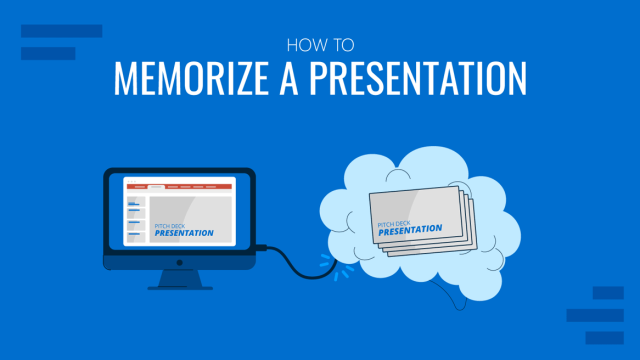
Filed under Education • July 10th, 2024
How to Memorize a Presentation: Guide + Templates
Become a proficient presenter by mastering the art of how to memorize a presentation. Nine different techniques + PPT templates here.

Filed under Design • July 3rd, 2024
ChatGPT Prompts for Presentations
Make ChatGPT your best ally for presentation design. Learn how to create effective ChatGPT prompts for presentations here.

Filed under Design • July 1st, 2024
Calculating the Slide Count: How Many Slides Do I Need for a Presentation?
There’s no magical formula for estimating presentation slides, but this guide can help us approximate the number of slides we need for a presentation.
Leave a Reply
Have a language expert improve your writing
Run a free plagiarism check in 10 minutes, generate accurate citations for free.
- Knowledge Base
- Starting the research process
- How to Write a Research Proposal | Examples & Templates
How to Write a Research Proposal | Examples & Templates
Published on October 12, 2022 by Shona McCombes and Tegan George. Revised on November 21, 2023.

A research proposal describes what you will investigate, why it’s important, and how you will conduct your research.
The format of a research proposal varies between fields, but most proposals will contain at least these elements:
Introduction
Literature review.
- Research design
Reference list
While the sections may vary, the overall objective is always the same. A research proposal serves as a blueprint and guide for your research plan, helping you get organized and feel confident in the path forward you choose to take.
Table of contents
Research proposal purpose, research proposal examples, research design and methods, contribution to knowledge, research schedule, other interesting articles, frequently asked questions about research proposals.
Academics often have to write research proposals to get funding for their projects. As a student, you might have to write a research proposal as part of a grad school application , or prior to starting your thesis or dissertation .
In addition to helping you figure out what your research can look like, a proposal can also serve to demonstrate why your project is worth pursuing to a funder, educational institution, or supervisor.
| Show your reader why your project is interesting, original, and important. | |
| Demonstrate your comfort and familiarity with your field. Show that you understand the current state of research on your topic. | |
| Make a case for your . Demonstrate that you have carefully thought about the data, tools, and procedures necessary to conduct your research. | |
| Confirm that your project is feasible within the timeline of your program or funding deadline. |
Research proposal length
The length of a research proposal can vary quite a bit. A bachelor’s or master’s thesis proposal can be just a few pages, while proposals for PhD dissertations or research funding are usually much longer and more detailed. Your supervisor can help you determine the best length for your work.
One trick to get started is to think of your proposal’s structure as a shorter version of your thesis or dissertation , only without the results , conclusion and discussion sections.
Download our research proposal template
Prevent plagiarism. Run a free check.
Writing a research proposal can be quite challenging, but a good starting point could be to look at some examples. We’ve included a few for you below.
- Example research proposal #1: “A Conceptual Framework for Scheduling Constraint Management”
- Example research proposal #2: “Medical Students as Mediators of Change in Tobacco Use”
Like your dissertation or thesis, the proposal will usually have a title page that includes:
- The proposed title of your project
- Your supervisor’s name
- Your institution and department
The first part of your proposal is the initial pitch for your project. Make sure it succinctly explains what you want to do and why.
Your introduction should:
- Introduce your topic
- Give necessary background and context
- Outline your problem statement and research questions
To guide your introduction , include information about:
- Who could have an interest in the topic (e.g., scientists, policymakers)
- How much is already known about the topic
- What is missing from this current knowledge
- What new insights your research will contribute
- Why you believe this research is worth doing
Receive feedback on language, structure, and formatting
Professional editors proofread and edit your paper by focusing on:
- Academic style
- Vague sentences
- Style consistency
See an example

As you get started, it’s important to demonstrate that you’re familiar with the most important research on your topic. A strong literature review shows your reader that your project has a solid foundation in existing knowledge or theory. It also shows that you’re not simply repeating what other people have already done or said, but rather using existing research as a jumping-off point for your own.
In this section, share exactly how your project will contribute to ongoing conversations in the field by:
- Comparing and contrasting the main theories, methods, and debates
- Examining the strengths and weaknesses of different approaches
- Explaining how will you build on, challenge, or synthesize prior scholarship
Following the literature review, restate your main objectives . This brings the focus back to your own project. Next, your research design or methodology section will describe your overall approach, and the practical steps you will take to answer your research questions.
| ? or ? , , or research design? | |
| , )? ? | |
| , , , )? | |
| ? |
To finish your proposal on a strong note, explore the potential implications of your research for your field. Emphasize again what you aim to contribute and why it matters.
For example, your results might have implications for:
- Improving best practices
- Informing policymaking decisions
- Strengthening a theory or model
- Challenging popular or scientific beliefs
- Creating a basis for future research
Last but not least, your research proposal must include correct citations for every source you have used, compiled in a reference list . To create citations quickly and easily, you can use our free APA citation generator .
Some institutions or funders require a detailed timeline of the project, asking you to forecast what you will do at each stage and how long it may take. While not always required, be sure to check the requirements of your project.
Here’s an example schedule to help you get started. You can also download a template at the button below.
Download our research schedule template
| Research phase | Objectives | Deadline |
|---|---|---|
| 1. Background research and literature review | 20th January | |
| 2. Research design planning | and data analysis methods | 13th February |
| 3. Data collection and preparation | with selected participants and code interviews | 24th March |
| 4. Data analysis | of interview transcripts | 22nd April |
| 5. Writing | 17th June | |
| 6. Revision | final work | 28th July |
If you are applying for research funding, chances are you will have to include a detailed budget. This shows your estimates of how much each part of your project will cost.
Make sure to check what type of costs the funding body will agree to cover. For each item, include:
- Cost : exactly how much money do you need?
- Justification : why is this cost necessary to complete the research?
- Source : how did you calculate the amount?
To determine your budget, think about:
- Travel costs : do you need to go somewhere to collect your data? How will you get there, and how much time will you need? What will you do there (e.g., interviews, archival research)?
- Materials : do you need access to any tools or technologies?
- Help : do you need to hire any research assistants for the project? What will they do, and how much will you pay them?
If you want to know more about the research process , methodology , research bias , or statistics , make sure to check out some of our other articles with explanations and examples.
Methodology
- Sampling methods
- Simple random sampling
- Stratified sampling
- Cluster sampling
- Likert scales
- Reproducibility
Statistics
- Null hypothesis
- Statistical power
- Probability distribution
- Effect size
- Poisson distribution
Research bias
- Optimism bias
- Cognitive bias
- Implicit bias
- Hawthorne effect
- Anchoring bias
- Explicit bias
Once you’ve decided on your research objectives , you need to explain them in your paper, at the end of your problem statement .
Keep your research objectives clear and concise, and use appropriate verbs to accurately convey the work that you will carry out for each one.
I will compare …
A research aim is a broad statement indicating the general purpose of your research project. It should appear in your introduction at the end of your problem statement , before your research objectives.
Research objectives are more specific than your research aim. They indicate the specific ways you’ll address the overarching aim.
A PhD, which is short for philosophiae doctor (doctor of philosophy in Latin), is the highest university degree that can be obtained. In a PhD, students spend 3–5 years writing a dissertation , which aims to make a significant, original contribution to current knowledge.
A PhD is intended to prepare students for a career as a researcher, whether that be in academia, the public sector, or the private sector.
A master’s is a 1- or 2-year graduate degree that can prepare you for a variety of careers.
All master’s involve graduate-level coursework. Some are research-intensive and intend to prepare students for further study in a PhD; these usually require their students to write a master’s thesis . Others focus on professional training for a specific career.
Critical thinking refers to the ability to evaluate information and to be aware of biases or assumptions, including your own.
Like information literacy , it involves evaluating arguments, identifying and solving problems in an objective and systematic way, and clearly communicating your ideas.
The best way to remember the difference between a research plan and a research proposal is that they have fundamentally different audiences. A research plan helps you, the researcher, organize your thoughts. On the other hand, a dissertation proposal or research proposal aims to convince others (e.g., a supervisor, a funding body, or a dissertation committee) that your research topic is relevant and worthy of being conducted.
Cite this Scribbr article
If you want to cite this source, you can copy and paste the citation or click the “Cite this Scribbr article” button to automatically add the citation to our free Citation Generator.
McCombes, S. & George, T. (2023, November 21). How to Write a Research Proposal | Examples & Templates. Scribbr. Retrieved July 16, 2024, from https://www.scribbr.com/research-process/research-proposal/
Is this article helpful?
Shona McCombes
Other students also liked, how to write a problem statement | guide & examples, writing strong research questions | criteria & examples, how to write a literature review | guide, examples, & templates, get unlimited documents corrected.
✔ Free APA citation check included ✔ Unlimited document corrections ✔ Specialized in correcting academic texts
- Research Process
- Manuscript Preparation
- Manuscript Review
- Publication Process
- Publication Recognition
- Language Editing Services
- Translation Services

How to Make a PowerPoint Presentation of Your Research Paper
- 4 minute read
- 132.8K views
Table of Contents
A research paper presentation is often used at conferences and in other settings where you have an opportunity to share your research, and get feedback from your colleagues. Although it may seem as simple as summarizing your research and sharing your knowledge, successful research paper PowerPoint presentation examples show us that there’s a little bit more than that involved.
In this article, we’ll highlight how to make a PowerPoint presentation from a research paper, and what to include (as well as what NOT to include). We’ll also touch on how to present a research paper at a conference.
Purpose of a Research Paper Presentation
The purpose of presenting your paper at a conference or forum is different from the purpose of conducting your research and writing up your paper. In this setting, you want to highlight your work instead of including every detail of your research. Likewise, a presentation is an excellent opportunity to get direct feedback from your colleagues in the field. But, perhaps the main reason for presenting your research is to spark interest in your work, and entice the audience to read your research paper.
So, yes, your presentation should summarize your work, but it needs to do so in a way that encourages your audience to seek out your work, and share their interest in your work with others. It’s not enough just to present your research dryly, to get information out there. More important is to encourage engagement with you, your research, and your work.
Tips for Creating Your Research Paper Presentation
In addition to basic PowerPoint presentation recommendations, which we’ll cover later in this article, think about the following when you’re putting together your research paper presentation:
- Know your audience : First and foremost, who are you presenting to? Students? Experts in your field? Potential funders? Non-experts? The truth is that your audience will probably have a bit of a mix of all of the above. So, make sure you keep that in mind as you prepare your presentation.
Know more about: Discover the Target Audience .
- Your audience is human : In other words, they may be tired, they might be wondering why they’re there, and they will, at some point, be tuning out. So, take steps to help them stay interested in your presentation. You can do that by utilizing effective visuals, summarize your conclusions early, and keep your research easy to understand.
- Running outline : It’s not IF your audience will drift off, or get lost…it’s WHEN. Keep a running outline, either within the presentation or via a handout. Use visual and verbal clues to highlight where you are in the presentation.
- Where does your research fit in? You should know of work related to your research, but you don’t have to cite every example. In addition, keep references in your presentation to the end, or in the handout. Your audience is there to hear about your work.
- Plan B : Anticipate possible questions for your presentation, and prepare slides that answer those specific questions in more detail, but have them at the END of your presentation. You can then jump to them, IF needed.
What Makes a PowerPoint Presentation Effective?
You’ve probably attended a presentation where the presenter reads off of their PowerPoint outline, word for word. Or where the presentation is busy, disorganized, or includes too much information. Here are some simple tips for creating an effective PowerPoint Presentation.
- Less is more: You want to give enough information to make your audience want to read your paper. So include details, but not too many, and avoid too many formulas and technical jargon.
- Clean and professional : Avoid excessive colors, distracting backgrounds, font changes, animations, and too many words. Instead of whole paragraphs, bullet points with just a few words to summarize and highlight are best.
- Know your real-estate : Each slide has a limited amount of space. Use it wisely. Typically one, no more than two points per slide. Balance each slide visually. Utilize illustrations when needed; not extraneously.
- Keep things visual : Remember, a PowerPoint presentation is a powerful tool to present things visually. Use visual graphs over tables and scientific illustrations over long text. Keep your visuals clean and professional, just like any text you include in your presentation.
Know more about our Scientific Illustrations Services .
Another key to an effective presentation is to practice, practice, and then practice some more. When you’re done with your PowerPoint, go through it with friends and colleagues to see if you need to add (or delete excessive) information. Double and triple check for typos and errors. Know the presentation inside and out, so when you’re in front of your audience, you’ll feel confident and comfortable.
How to Present a Research Paper
If your PowerPoint presentation is solid, and you’ve practiced your presentation, that’s half the battle. Follow the basic advice to keep your audience engaged and interested by making eye contact, encouraging questions, and presenting your information with enthusiasm.
We encourage you to read our articles on how to present a scientific journal article and tips on giving good scientific presentations .
Language Editing Plus
Improve the flow and writing of your research paper with Language Editing Plus. This service includes unlimited editing, manuscript formatting for the journal of your choice, reference check and even a customized cover letter. Learn more here , and get started today!

Know How to Structure Your PhD Thesis

Systematic Literature Review or Literature Review?
You may also like.

What is a Good H-index?

What is a Corresponding Author?

How to Submit a Paper for Publication in a Journal
Input your search keywords and press Enter.
Presenting Your Research
A WORD Studio guide to presenting your research.
I. The Research Proposal Presentation
The overall purpose of a research proposal presentation is inquiry: you’re sharing what you’ve learned so far and how you hope to develop it so that you might hear from others what questions they have, where they felt confused, and new directions they think you might pursue.
WHAT TO SAY
- Remember that the proposal presentation is about your work in progress. You don’t have to have firm conclusions yet. Offer some possible ends you see reaching, and find out from your audience whether they think those are achievable.
- Don’t worry at this point about having every statistic lined up to support yourself or every quotation at hand. However, do be able to speak confidently about what the major scholars you’ve read have argued.
- Discuss your methodology, both what you have already done and what else you hope to do. A classmate may have run into a source that would work well for you and can bring this up during this time.
HOW TO SAY IT
- Although you are on the spot for a somewhat formal presentation, think of the proposal presentation as a conversation. Be open to interruptions or questions as you go, and stop and ask questions yourself if some occur to you.
VISUAL AIDS
You might not use many visual aids during a proposal feedback session; a full PowerPoint show, for example, might not be feasible if you haven’t yet collected all the information you’d want to share in this visual medium. A handout, however, might be helpful. Consider a handout of the working outline of your final paper; don’t read the outline at your audience but call their attention to each section as it comes up in your presentation. And since it’s a working outline, you can solicit advice from your listeners on how you might improve the organization or the development of ideas.
Active Listening and Peer Feedback
- Remember that the feedback you provide here will have a direct impact on the way your classmate shapes his or her final research project.
- Take notes (on an outline, if provided) with questions you have or terms you want better explained. Also note any parts of the proposal that sounded particularly interesting or fruitful. However, don’t let note-taking keep you from giving attention and eye contact to the speaker.
- Try to make a sketch of the speaker’s organizational scheme—even if the speaker has provided you with an outline, you may find as a listener that the speaker skips around or needs to bring related points closer together.
- When it comes time to offer feedback, make comments that are constructive and specific rather than general. For example, instead of saying, “I was confused by your organization,” say, “The section on the economic implications of the Beijing Olympics needs to go earlier.”
- Ask the presenter what visual aids they might plan to use in the final presentation. Make specific suggestions about what the audience might find helpful: “I’d like to see images of Beijing clean-up” or “You’ll probably want to offer a graph that shows how the population changed over time.”
II. The Final Research Presentation
Once you have completed your research project, you’ll want to share your findings and conclusions with others, helping each other add to the knowledge base you will all draw on as you continue your conversation with others in the field.
- Begin by making a sentence outline of your entire paper—this entails summarizing each paragraph in a single sentence and organizing those sentences into smaller paragraphs of related points.
- Then, keeping in mind the time allotted for your presentation, cut out any of these sentences that are interesting but not vital for an audience’s understanding.
- Using your pared-down sentence outline, find one or two specific pieces of evidence from your research to support each; then work on smooth transitions between all the sections. Depending on the context of your presentation, you might add introductory remarks about your methodology.
- Although one or two well-placed quotations can help add some power and authority to your presentation, don’t overwhelm your audience by reading many long quotations from other sources, no matter how interesting or well-written they may be—listeners might get confused about where the quote begins or ends, or whether it’s a quotation at all.
- Similarly, decide which statistics, facts, figures, or dates are essential for you to discuss aloud. If you must show a progression over time or make a comparison of statistics, use a visual aid of some sort to display the information rather than trying to make listeners strain to keep it all straight.
- Prepare ahead of time for questions: rehearse your presentation in front of a friend or WORD Studio tutor and ask them to lob the questions they might imagine your listeners having.
- If possible and permissible within the context of your presentation, add an interactive element, something that asks the audience to respond to you or to each other. This can be as simple as taking a show of hands on a few questions to see how much your audience knows, or asking them to describe to you what they see on a visual aid (for example, telling you what a graph seems to be showing).
VISUAL AIDS:
Handouts can be useful for showing data that you want everyone to look at several times (rather than having them squint at a PowerPoint slide); handouts can also be a place to gather some of the important quotations that you don’t read aloud during your presentation. Avoid the temptation to simply read a handout straight through to your audience; even consider not giving the handout out until near the end of the presentation.
PowerPoint might be preferable to handouts if you have many different data sets you need to go through, or if you want to display visual images (photographs, maps, etc.) to complement your discussion. Using PowerPoint well is an art; consult with good online guides or a WORD Studio tutor for more advice.
- Since you’ve heard your classmates’ proposals, you already have an idea of what the presentation will cover. Before a classmate begins speaking, therefore, identify at least one question you have and listen to see how (or if) they answer it.
- Use handouts actively: take notes, underline key points, jot down questions in the margin.
- If the speaker gives a PowerPoint presentation, consider it a visual outline of the overall presentation. Don’t attempt to write down everything on a slide; instead, write down one key point from each to remind yourself of questions and observations later.
- If this is a final research product, offering structural feedback might not be that helpful. Instead, aim for questions about content that might engender further thought in the speaker and the rest of the audience—even if the speaker never revises this particular research project further, he or she will have been exposed to new venues of exploration through your questions.
- How we work
How to Present Research Proposal Convincingly and Effectively
Correct research proposal presentation is essential in getting your research approved.

Why Is a Proposal for Presentation Important?
A presentation is an essential component that will help you showcase your research from the best angle. It is a roadmap that shows your central research question, how you will find the solution, and what awarenesses and issues stand in your way. A way to present research proposal writing in the form of a paper is essential, but it sets limits on your abilities to demonstrate the content to the audience.
Having a set of slides is good because it is more understandable than writing. Showcasing your future project using graphics and tables is even better because the information becomes more convincing and coherent. Sometimes, the presentation allows individuals to say more than they could do when writing a research plan. Let’s move on and discover how to make research proposal presentation.
4 Steps to Create a Great Thesis Proposal Presentation
When you present your project, you literally sell it to the officials, proving its value and importance within the whole field. That’s why it’s essential to consider valuable points when working on the project. So, below are points to follow when preparing research proposal presentation.
- Show the topic knowledge. Your task is to present fresh ideas and show how well you know the subject. By doing so, you demonstrate how well you studied the topic and understand what should be added to the existing gaps.
- Structure your content. It works the same as with writing and should flow logically. You should smoothly move from one part to another, showcasing all aspects of your research. Also, ensure your presentation proposal does not contain information that does not belong to the topic.
- Use bulleted lists. It makes the writing readable and makes it easy for the audience to absorb the information. Moreover, writing huge sentences on slides has negative impact, so consider using bulleted lists as an alternative.
- Add visuals. Writing too much text is not good, as it is hard to perceive many words on slides visually. Add graphs, images, and infographics to make the information easier to understand. Nevertheless, keep enough ample space not to overload the slides.
Research proposal PowerPoint format allows you to be more creative using tools to compose and deliver the information. Start working beforehand to select the proper background, fonts, and visuals to ensure your slides look great. Still, if you find it difficult to complete the task, asking someone for assistance is a good decision. Consider getting professional help writing research proposal from our experienced pros.
What Should Research Proposal Presentation Consist Of?
When presenting the concept of your study, you should understand what it consists of and what is the purpose of each part. You will understand how to write a presentation proposal. Stick to this plan. Use it like a template, and make sure you include all the needed information. Another great idea is to use dissertation proposal guidelines provided by your institution. Besides, you can look for samples and check how others handle such a task.
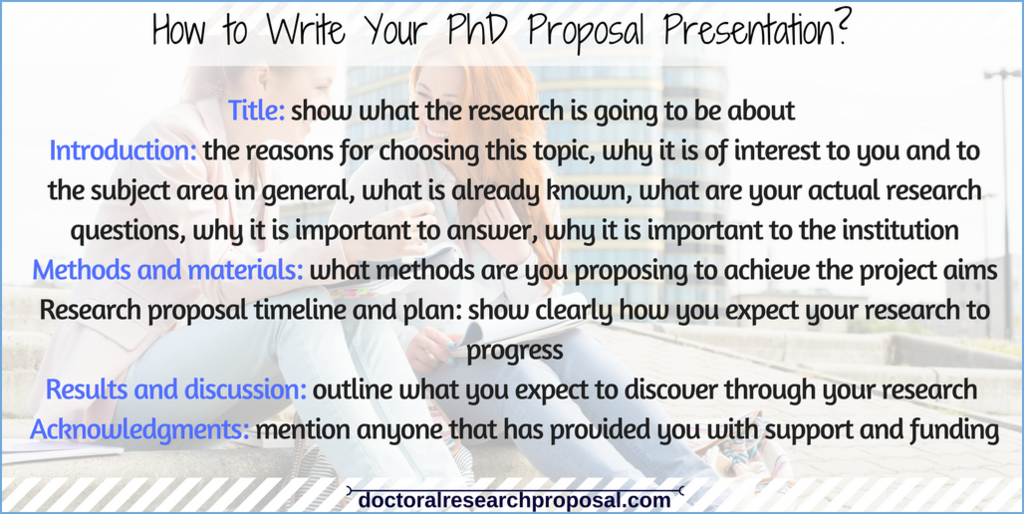
Tips to Effectively Present Research Proposal
The concept you create should be impressive and informative. Everything should be focused on your study, showcasing the topic, highlighting its importance, and saying what you expect to achieve. That’s why you should make your thesis proposal presentation a visual aid that helps the audience to understand you. Below are some tips to help you.
- Limit the amount of text on each slide. Focus on writing key phrases only.
- Create contrast by using different colors for text and background to enhance readability. The best combo is a “light text-black background.”
- Use simple design solutions and avoid flashy transitions because they may distract the audience.
- Don’t create too many slides. Decide how many slides you need in each part of your PhD proposal presentation, and don’t go beyond this number.
- Do not read from slides. The visual content is for the audience, so you should give them additional information.
- Avoid templates. There is no need to fit your original proposal for presentation into already-made structures.
To ensure the final version looks good, show it to someone who hasn’t seen it before. With feedback from an independent viewer, you will understand whether everything looks good or not.

How to Present a Research Proposal and Defense It
Simply switching the slides and repeating all the information is not enough. The purpose of the proposal defense is to convince the audience that your research is significant, fundamental, and worth investing in. Those who will listen to you won’t be very interested in research projects. So, how to present a research proposal in a way that makes them listen?
You have to be confident and stick to your agenda. Make notes about what you will say at each stage of the defense. Left the most significant information on the slides, supplementing it with additional abstracts during the demonstration. Keep the pace and show one slide per minute. Rushing is not what’s needed since you aim to show the research project’s significance.
The ability to answer audience questions is another essential of how to make a proposal presentation. Be ready for this because the committee may want to test how well you know your research topic. An unclear answer or a typical “I don’t know” can negatively impact their decision. Practice before the official demonstration and ensure you are confident enough to defend a presentation without notes.
Get Assisted in Creating a Proposal Presentation
Creating a proposal presentation is a responsible task because you are showcasing your future research, explaining why it’s important and how it will close the existing gaps in the field. It requires a deep analysis, which takes lots of time and effort and may be challenging for some individuals.
However, it’s not a problem for our specialists. As well as providing professional thesis writing services , we assist customers with presentation creation. Our experts carefully investigate the topic, do in-depth research, and find relevant data. Moreover, they can help you select research topics, offering unique niches that match your interests.
Contact us anytime you want to achieve outstanding quality and get the writing task done on time.

Upload Files
Thank you for your request!
We will get in touch with you shortly!
Please, try one more time.
We use essential cookies to make Venngage work. By clicking “Accept All Cookies”, you agree to the storing of cookies on your device to enhance site navigation, analyze site usage, and assist in our marketing efforts.
Manage Cookies
Cookies and similar technologies collect certain information about how you’re using our website. Some of them are essential, and without them you wouldn’t be able to use Venngage. But others are optional, and you get to choose whether we use them or not.
Strictly Necessary Cookies
These cookies are always on, as they’re essential for making Venngage work, and making it safe. Without these cookies, services you’ve asked for can’t be provided.
Show cookie providers
- Google Login
Functionality Cookies
These cookies help us provide enhanced functionality and personalisation, and remember your settings. They may be set by us or by third party providers.
Performance Cookies
These cookies help us analyze how many people are using Venngage, where they come from and how they're using it. If you opt out of these cookies, we can’t get feedback to make Venngage better for you and all our users.
- Google Analytics
Targeting Cookies
These cookies are set by our advertising partners to track your activity and show you relevant Venngage ads on other sites as you browse the internet.
- Google Tag Manager
- Infographics
- Daily Infographics
- Popular Templates
- Accessibility
- Graphic Design
- Graphs and Charts
- Data Visualization
- Human Resources
- Beginner Guides
Blog Business How to Write a Research Proposal: A Step-by-Step
How to Write a Research Proposal: A Step-by-Step
Written by: Danesh Ramuthi Nov 29, 2023

A research proposal is a structured outline for a planned study on a specific topic. It serves as a roadmap, guiding researchers through the process of converting their research idea into a feasible project.
The aim of a research proposal is multifold: it articulates the research problem, establishes a theoretical framework, outlines the research methodology and highlights the potential significance of the study. Importantly, it’s a critical tool for scholars seeking grant funding or approval for their research projects.
Crafting a good research proposal requires not only understanding your research topic and methodological approaches but also the ability to present your ideas clearly and persuasively. Explore Venngage’s Proposal Maker and Research Proposals Templates to begin your journey in writing a compelling research proposal.
What to include in a research proposal?
In a research proposal, include a clear statement of your research question or problem, along with an explanation of its significance. This should be followed by a literature review that situates your proposed study within the context of existing research.
Your proposal should also outline the research methodology, detailing how you plan to conduct your study, including data collection and analysis methods.
Additionally, include a theoretical framework that guides your research approach, a timeline or research schedule, and a budget if applicable. It’s important to also address the anticipated outcomes and potential implications of your study. A well-structured research proposal will clearly communicate your research objectives, methods and significance to the readers.

How to format a research proposal?
Formatting a research proposal involves adhering to a structured outline to ensure clarity and coherence. While specific requirements may vary, a standard research proposal typically includes the following elements:
- Title Page: Must include the title of your research proposal, your name and affiliations. The title should be concise and descriptive of your proposed research.
- Abstract: A brief summary of your proposal, usually not exceeding 250 words. It should highlight the research question, methodology and the potential impact of the study.
- Introduction: Introduces your research question or problem, explains its significance, and states the objectives of your study.
- Literature review: Here, you contextualize your research within existing scholarship, demonstrating your knowledge of the field and how your research will contribute to it.
- Methodology: Outline your research methods, including how you will collect and analyze data. This section should be detailed enough to show the feasibility and thoughtfulness of your approach.
- Timeline: Provide an estimated schedule for your research, breaking down the process into stages with a realistic timeline for each.
- Budget (if applicable): If your research requires funding, include a detailed budget outlining expected cost.
- References/Bibliography: List all sources referenced in your proposal in a consistent citation style.

How to write a research proposal in 11 steps?
Writing a research proposal template in structured steps ensures a comprehensive and coherent presentation of your research project. Let’s look at the explanation for each of the steps here:
Step 1: Title and Abstract Step 2: Introduction Step 3: Research objectives Step 4: Literature review Step 5: Methodology Step 6: Timeline Step 7: Resources Step 8: Ethical considerations Step 9: Expected outcomes and significance Step 10: References Step 11: Appendices
Step 1: title and abstract.
Select a concise, descriptive title and write an abstract summarizing your research question, objectives, methodology and expected outcomes. The abstract should include your research question, the objectives you aim to achieve, the methodology you plan to employ and the anticipated outcomes.
Step 2: Introduction
In this section, introduce the topic of your research, emphasizing its significance and relevance to the field. Articulate the research problem or question in clear terms and provide background context, which should include an overview of previous research in the field.
Step 3: Research objectives
Here, you’ll need to outline specific, clear and achievable objectives that align with your research problem. These objectives should be well-defined, focused and measurable, serving as the guiding pillars for your study. They help in establishing what you intend to accomplish through your research and provide a clear direction for your investigation.
Step 4: Literature review
In this part, conduct a thorough review of existing literature related to your research topic. This involves a detailed summary of key findings and major contributions from previous research. Identify existing gaps in the literature and articulate how your research aims to fill these gaps. The literature review not only shows your grasp of the subject matter but also how your research will contribute new insights or perspectives to the field.
Step 5: Methodology
Describe the design of your research and the methodologies you will employ. This should include detailed information on data collection methods, instruments to be used and analysis techniques. Justify the appropriateness of these methods for your research.
Step 6: Timeline
Construct a detailed timeline that maps out the major milestones and activities of your research project. Break the entire research process into smaller, manageable tasks and assign realistic time frames to each. This timeline should cover everything from the initial research phase to the final submission, including periods for data collection, analysis and report writing.
It helps in ensuring your project stays on track and demonstrates to reviewers that you have a well-thought-out plan for completing your research efficiently.
Step 7: Resources
Identify all the resources that will be required for your research, such as specific databases, laboratory equipment, software or funding. Provide details on how these resources will be accessed or acquired.
If your research requires funding, explain how it will be utilized effectively to support various aspects of the project.
Step 8: Ethical considerations
Address any ethical issues that may arise during your research. This is particularly important for research involving human subjects. Describe the measures you will take to ensure ethical standards are maintained, such as obtaining informed consent, ensuring participant privacy, and adhering to data protection regulations.
Here, in this section you should reassure reviewers that you are committed to conducting your research responsibly and ethically.
Step 9: Expected outcomes and significance
Articulate the expected outcomes or results of your research. Explain the potential impact and significance of these outcomes, whether in advancing academic knowledge, influencing policy or addressing specific societal or practical issues.
Step 10: References
Compile a comprehensive list of all the references cited in your proposal. Adhere to a consistent citation style (like APA or MLA) throughout your document. The reference section not only gives credit to the original authors of your sourced information but also strengthens the credibility of your proposal.
Step 11: Appendices
Include additional supporting materials that are pertinent to your research proposal. This can be survey questionnaires, interview guides, detailed data analysis plans or any supplementary information that supports the main text.
Appendices provide further depth to your proposal, showcasing the thoroughness of your preparation.

Research proposal FAQs
1. how long should a research proposal be.
The length of a research proposal can vary depending on the requirements of the academic institution, funding body or specific guidelines provided. Generally, research proposals range from 500 to 1500 words or about one to a few pages long. It’s important to provide enough detail to clearly convey your research idea, objectives and methodology, while being concise. Always check
2. Why is the research plan pivotal to a research project?
The research plan is pivotal to a research project because it acts as a blueprint, guiding every phase of the study. It outlines the objectives, methodology, timeline and expected outcomes, providing a structured approach and ensuring that the research is systematically conducted.
A well-crafted plan helps in identifying potential challenges, allocating resources efficiently and maintaining focus on the research goals. It is also essential for communicating the project’s feasibility and importance to stakeholders, such as funding bodies or academic supervisors.

Mastering how to write a research proposal is an essential skill for any scholar, whether in social and behavioral sciences, academic writing or any field requiring scholarly research. From this article, you have learned key components, from the literature review to the research design, helping you develop a persuasive and well-structured proposal.
Remember, a good research proposal not only highlights your proposed research and methodology but also demonstrates its relevance and potential impact.
For additional support, consider utilizing Venngage’s Proposal Maker and Research Proposals Templates , valuable tools in crafting a compelling proposal that stands out.
Whether it’s for grant funding, a research paper or a dissertation proposal, these resources can assist in transforming your research idea into a successful submission.
Discover popular designs

Infographic maker

Brochure maker

White paper online

Newsletter creator

Flyer maker

Timeline maker

Letterhead maker

Mind map maker

Ebook maker
- Design for Business
- Most Recent
- Presentations
- Infographics
- Data Visualizations
- Forms and Surveys
- Video & Animation
- Case Studies
- Digital Marketing
- Design Inspiration
- Visual Thinking
- Product Updates
- Visme Webinars
- Artificial Intelligence
How to Create an Expert Research Proposal (+Templates)

Written by: Idorenyin Uko

Beyond serving as a blueprint for the entire study, it lays the groundwork for a smooth and efficient research process.
Research proposals detail what you’ll cover in a larger research project. Whether you're a graduate student or a seasoned professor seeking to expand your current project, you’re going to need one to secure approvals from relevant committees and request funding for the project.
With a solid proposal in place, your research project can proceed with confidence, clarity and focus.
However, writing a research proposal is daunting and can overwhelm even the most seasoned researchers. In this comprehensive guide, we'll share expert research proposal templates to spotlight your project.
We'll also share tips and best practices to help you create a proposal that will impress reviewers and secure funding for your project.
Let’s get to it.
Table of Contents
What should a research proposal include, research proposal examples, how to create a research proposal with visme, best practices when writing a research proposal.
- A research proposal is a document that outlines the strategy and justification for a research project. It is usually submitted to gain approval and funding for conducting the research.
- This document provides a detailed description of the research question, the methodology, the expected outcomes and the potential contributions of the research.
- A research proposal aims to persuade the reader, usually a funding agency or a research committee, that the proposed research is worthwhile and deserves support.
- To create a research proposal in Visme, use premade templates, write the content, visualize important data, customize your research proposal, download it and share it with relevant stakeholders
- Here are tips and best practices for creating a research proposal: understand the requirements, get feedback from peers and mentors, revise and edit your proposal and incorporate relevant visual aids.
- Visme has a wide range of proposal template s, tools and features to help you create winning research proposals.
First of all, what is a research proposal? A research proposal is a structured document that outlines the plan and rationale for a research project. It is typically submitted to gain approval and funding for conducting the research.
The specific requirements might vary depending on the institution, field of study and purpose of the research.
However, a comprehensive research proposal generally includes the following components:
Made with Visme Infographic Maker
The title page is the first thing readers see when they open your research proposal. It should contain the following details:
- The proposed title of your research proposal
- The institution and department
- Contact details
- Your supervisor's or advisor’s name Date of submission
If an external organization is sponsoring your research, provide client or funder details.
When crafting the title of your research proposal, keep it concise yet informative. Also, make sure it accurately reflects the focus of your research project.
Abstract and Table of Contents
If your proposal is lengthy, consider adding an abstract and table of contents.
A table of contents provides readers (such as reviewers, advisors, or funding committee members) with an organized overview of the proposal's structure. They can easily navigate and find specific information without flipping through the entire document.
- List all the major sections and subsections of your proposal
- Use clear and concise headings that represent the content of each section
- Provide page numbers for each section so that readers can easily locate them
- Keep the table of contents updated if you change the document's structure or page numbers
Introduction
The introduction is a critical part of your research proposal. It sets the tone for the rest of the document and provides a framework for understanding the research. Make sure it piques your audience's interest and briefly explains what you want to achieve and why.
Here are some details you should include in your introduction:
- Background information on the topic
- Relevant literature, theories and existing research in the field
- The objectives of the study and motivations
- Problem statement or research questions
- The significance of the research
- Previous research or studies that have been conducted in the area
- A brief summary of the research methodology being used and how the data will be analyzed
When building your introduction, here are some ideas or questions to guide your thoughts:
- Why is the research necessary?
- How much work has already been done on the topic?
- How does it contribute to the existing body of knowledge?
- What is the gap in knowledge or the specific problem that your research aims to address?
- Who might be interested in this topic? (e.g., Industries and corporations, government agencies, non-governmental organizations (NGOs), think tanks and academia?)
Literature Review
The literature is where you demonstrate your understanding of the existing knowledge in the field. In addition, a well-written literature review achieves these things:
- Justifies the need for your research
- Summarize the key findings and arguments of relevant studies
- Identify gaps in current knowledge and explain how your research will address these gaps
To write a compelling literature review, conducting thorough research beyond a narrow focus on just a few studies is essential. Instead, aim to investigate a broad range of theories, methods and debates within your field.
Not only will this help you identify the similarities and differences between various approaches, but it will also enable you to critically evaluate their strengths and weaknesses. You'll also be able to demonstrate how your own research builds upon, challenges, or synthesizes prior studies.
This approach will enrich your understanding of the subject matter and lend credibility and depth to your review. To provide a comprehensive overview of the subject matter, tap into different information sources, such as:
- Scholarly articles
- Conference papers and proceedings
- Journal publications
- Government statistics and data
- Industry reports and whitepapers
- Surveys and peer group sessions
- Textbooks, monographs and edited volumes
- Online search engines
- News articles
- Social media and online communities
- Professional associations and networks and much more.
Research Design and Methodology
The research methodology is the backbone of any research project. Whether you’re preparing a research proposal or research presentation , it not only shapes the entire research process but also determines the quality, reliability and credibility of the study's outcomes.
The section should outline the specific methods and practical steps you plan to use to conduct your research. Describe the overall approach, including the research design, methods, data collection and analysis techniques and procedures for data interpretation.
Specifically, this section should capture these details:
Research Approach
- Qualitative, quantitative, or mixed methods?
- Data sources—primary, secondary and tertiary sources, archival data, unpublished data
- Chosen research designs—experimental, non-experimental, descriptive, correlational, retrospective, prospective, cross-sectional, etc.?
Population and Sample
- Who or what will you study? (individuals, groups, objects, phenomena, or concepts)
- How will you select your subjects, items, or data points from a larger population? Sampling strategy examples include random, non-random, systematic, probability, non-probability, cluster sampling, etc.
- What will the size of the sample be?
- When, where and how will you collect your data?
Research Methods
- What data collection procedures and tools will you use (e.g., surveys, interviews, observations and experiments)?
- Why are you using this design and data collection method?
Data Analysis
- How you will analyze the collected data (e.g., statistical techniques, content analysis, thematic analysis)?
- What data analysis tools are you using?
Ethical Considerations
- How will you get informed consent from participants?
- What approach will you take to protect vulnerable populations, like minors, seniors, or those lacking autonomy?
- How will you respect participants' privacy and prevent unauthorized access to their information?
- What steps will you take to manage and disclose any potential conflicts of interest?
Practicalities
- What is the anticipated timeframe for data collection, analysis and reporting?
- How do you plan to secure access to the target population for your research?
- How will you facilitate effective communication channels among team members, collaborators and stakeholders involved in the research?
- How will you address logistical considerations such as travel, fieldwork arrangements and scheduling interviews or surveys?
- What strategies will you employ to overcome any challenges or barriers?
Contribution to Knowledge
This section should explain how your research addresses the identified gap and its potential contributions and impact on the field of study, policy or society.
To make a compelling case for your research, identify practical applications and policy implications of your study. Also, describe how your research will advance knowledge or understanding in the field.
For example, your research has the potential to make a significant impact in various ways, such as:
- Enhancing best practices in the field
- Informing policy decisions with evidence-based insights
- Contributing to the development or refinement of theoretical models
- Challenging prevailing beliefs or assumptions in the scientific community
- Laying the groundwork for future research initiatives
Reference List
List all the sources cited in your research proposal. Your references must be formatted according to the appropriate citation style (APA, MLA, or Chicago). In the reference list, make sure to include a mix of primary and secondary sources and recent and classic works.
Properly reference your sources to avoid plagiarism and credit the original authors. This will show your commitment to academic integrity and ensure that your research is built on a solid foundation of existing knowledge.
Research Schedule and Timeline
When writing your research proposal, provide a detailed timeline for completing each stage of the research process. Create a table with activities on one side and estimated completion dates on the other. Allow for flexibility in case unexpected issues arise during the research process.
Here’s an example of a research schedule:
When applying for research funding, a detailed budget is typically required. This document outlines your estimated costs and resources needed to complete each aspect of your project,
Before drafting your budget, verify the types of expenses that the funding body will cover. Then, for each item, include the following information:
- Cost: Specify the exact amount of funds requested.
- Justification: Explain why this cost is essential to the research's success.
- Source: Describe how you calculated the amount.
To determine your budget, consider the following categories:
- Travel costs: Will you need to travel to gather data? If so, factor in transportation, accommodation and subsistence expenses. Also, account for the time spent traveling and the specific activities you plan to conduct at each location (e.g., interviews, archival research).
- Materials: Are there any tools or technologies you need access to? Include costs for equipment, software, or other materials essential to your research.
- Assistance: Will you require research assistants for tasks such as data collection, analysis, or transcription? Specify the number of assistants needed, their roles and the compensation they will receive.
Remember to include contingencies and unexpected expenses that may arise during the research process.
Attach any additional materials that support your proposal, such as survey questionnaires, informed consent forms, or supplementary information.
The appendices should be well organized, labeled and easy to navigate. Make sure to only include supplementary materials or documents that:
- Provide additional information to support your proposal
- Enhance the understanding of your research proposal
- Serve as a valuable reference for future use
Wondering what great research proposals look like. Here are a few research proposal examples and templates to help you start on the right foot.
1. Research Proposal Presentation Template
Are you tired of boring research proposals that put your audience to sleep? Look no further! This research proposal sample is just what you need to create a presentation that stands out from the crowd. Not only does our template feature a stylish blend of blue and white color themes, but it also incorporates eye-catching red bars in each slide to grab your audience's attention.
The subtle background images add a touch of elegance. The circular images and icons drive visual interest, while the table helps you visualize the proposed research timeline easily.
But that's not all—the template is also fully customizable, so you can easily tailor it to fit your specific research project.
You can edit content, swap image(s), apply custom colors, use your own fonts and logo and more. Plus, it's easy to follow and navigate, ensuring your audience stays engaged and interested throughout your presentation.
And don't forget about the content! Our template includes sections to help you articulate your research background, questions, objectives, literature review, methods and plan in a concise manner.

2. Research Grant Proposal Template
Unlock the door to funding success with our cutting-edge research proposal template. This template features a bold and modern design with vibrant colors, compelling images, and dynamic graphics.
With a professional layout and engaging visual elements, this template is the perfect tool to help you showcase your ideas and make a lasting impression on funding agencies.
Feel free to change colors or fonts and stand out from the crowd. Take advantage of customizable charts and widgets to help you visualize key data. Download this template and increase your chances of securing the grants you need to drive your research forward.

RELATED: 9 Winning Grant Proposal Templates & How to Write One
3. Health Care Research Proposal Template
Get ready to take your research to the next level with the help of our innovative one-page proposal template.
This template distills your ideas into a concise summary. But despite its brevity, this template captures the essence of a research project, conveying the key elements in a concise and compelling way.
Another key feature of this template is its clean and elegant layout. The structure is organized into clear and logical sections, each building on the previous one to create a coherent narrative.
These visuals are well-designed and easy to interpret. But you can spice it up further with Visme's interactive elements . You have the option of adding hover effects or pop-ups to reveal additional information. Or just add hotspots that link to the full research proposal, website or landing page
Whether you're a seasoned researcher or just starting out, this template will inspire your proposals and help you secure funding for your next research project.
4. Sales Research Proposal Template
Confidently present your request for research funding focused on sales-based topics or survey proposals by using this research proposal template.

Its minimalist layout with monochromatic tones allows you to eloquently lay out background information, objectives, methodology, budget, as well as the expected impact, key performance indicators (KPIs), and your research expectations.
You can also change the color palette of the template to a much brighter tone or to match your brand colors with ease. Visme provides a wide range of color palette options you can instantly change your template to or allow you to customize manually.
In addition to customizing it to your brand, you can also add dynamic fields. Dynamic fields enable you to instantly update information, data, dates, and more across multiple projects with just one click. You can use dynamic fields for your company details, results, or modify the proposal's recipient should you plan on sending multiple proposals to prospective funders or clients.
5. General Funding Research Proposal Template
Maybe you're looking for a template that comes with a striking design, one that is sure to create a great first impression with your potential sponsors. This general funding research proposal aligns with all these requirements.

This contemporary design features a soft pink color scheme with black accents and fonts, complemented by warm and brown-toned images. It also incorporates ample empty space, ensuring a clutter-free and straightforward layout to enhance readability while directing the reader's attention to key aspects of the provided text.
This template is not only customizable but can also be effortlessly adapted for any topic, regardless of the type of research request you have in mind. Edit, add, or remove pages as needed until you have completed your research proposal to complete satisfaction.
6. Product Research Proposal Template
As a product manager or expert, you want to ensure that your product research is positioned in a way that stands out against the competition. Here's a product research proposal template that not only neatly packages your request but also leverages the power of storytelling and dynamic graphics and designs to persuade readers to support your proposal.

This template is designed with black tones and fun accents of yellow and white. Each element is balanced to provide a futuristic yet vibrant look and feel.
The pages feature tech-forward and focused layouts, enabling you to present key objectives, use structured flowcharts or diagrams to illustrate your methodology, and include a timeline tree that outlines the entire execution process from start to finish.
7. Tech Research Proposal Template
Most people are visual learners and are more likely to remember your proposals and their content through the visuals you use. If you’re looking for a proposal that smartly uses visuals to make your content more memorable, then this tech research proposal template takes a brilliant approach to balancing text and the heavy use of imagery.

The theme features strong tones of purple, complemented by white and yellow accents. Each page is presented with beautiful visuals that match the content presented. It is also accompanied by simple icons, charts, and graphs that align with the overall theme.
You can easily replace the current images by uploading your own. Maybe the images you have look great but need a bit of editing. Use Visme's AI Touch-Up Tools to quickly unblur, sharpen, remove backgrounds, or erase and replace items until your image is perfect and ready to be used in your template.
8. Marketing Research Proposal Template
For marketers who need a tech-focused design approach to impress potential clients and attract sponsors for funding, this template is tailor-made for you. It was designed with marketers in mind, offering sections for the scope of work, budget overview, research timeline. It includes placeholders for you to add your website, company logo, or brand colors.

Visme allows you to elevate your presentation game, whether you're presenting your research proposal in person or virtually. With Visme, you can:
- Publish your proposals as a live webpage that reflects real-time updates.
- Use Visme's presenter studio to record your proposal presentation and send it to prospective clients or sponsors as an MP4.
- Download it as a PDF for online or print, giving your readers the flexibility to review it as they prefer.
- And so much more.
9. Environmental Research Proposal Template
This environmental research proposal template is an excellent choice for nonprofits and environmentalists who want to create effective proposals without resorting to overused, boring, or rigid designs.

The template features a white background with green tones and imagery. Its composition is separate, spacious, and filled with clean empty spaces, making it easy to read. It also conveys a calm and peaceful tone that complements any environmental or non-profit topic you intend to use it for.
If you're working on this environmental research proposal with a team, utilize Visme's Workflow feature . This feature helps you eliminate endless email chains and Slack messages, allowing you to manage roles, tasks, progress, and deadlines all in one place. You can set deadlines, add and reply to comments, and even work on your proposal simultaneously without conflicts.
10. General Approval Research Proposal Template
If you are a professional in the medical field seeking to craft a research proposal for approval, this template offers a compelling design layout tailored to the aesthetics of your industry. It has been meticulously designed with a minimalist approach, enabling you to present your request in a polished layout while incorporating vivid and stunning imagery.

Not to mention, for any section of your research proposal where you need to showcase previous data or results, you can seamlessly import your data from sources such as Google Sheets, Excel, or other tools directly into your charts and graphs.
Watch the video below to see how the feature works.
Once your data sources are linked, your charts and graphs will automatically update to reflect any changes made in the external data sources, ensuring that your information remains organized and up-to-date. This functionality enhances the professional presentation of your research proposal while streamlining data management.
A research proposal doesn’t have to be a long, boring document.
With the wide variety of features and templates available in Visme, you can whip up a visually appealing and professional-looking research proposal.
Here’s how to write a research proposal using Visme.
Step 1: Register or Log in to your Visme Account
Sign up for a new Visme account or log into your account (if you’re an existing user). Fill in your login details in the form and you’ll be redirected to the dashboard.
Either way, you'll be able to start exploring all the amazing features and tools that Visme has to offer!

Step 2: Use Premade Templates or Start from Scratch
The next step is to create your proposal. You have the option of starting from scratch or using premade templates.
But why start from scratch when you can build on research proposal examples?
Take advantage of Visme's customizable research proposal templates to streamline your workflow and easily create a professional-looking proposal.
By using a pre-designed research project proposal template, you'll save time and effort while ensuring that your proposal adheres to the standard guidelines and best practices of the research community.
With a wide range of templates available in Visme’s library, you're sure to find a research proposal sample that fits your needs
In the Visme dashboard, click Create New>Project and scroll to the category–Proposal . Browse through the collection of templates until you find one that best fits your industry or company.
Step 3: Write the Content
Once you’ve selected your template, the next move is to write the content.
We’ve already broken down the key elements in a professional research proposal. But stick to the sections recommended by the funding agency or academic institution.
All you need to do is swap out the template’s placeholder content with yours. Visme’s intuitive editor makes it easy for you to add, edit or remove content or move design elements around the canvas.
You can modify your text, including adding, removing and adjusting the font size, style and color. The editor also includes options for changing text alignment and arrangement and animating your text.
When it comes to writing content, the Visme AI writer ensures you never run out of ideas. Simply input your prompt and the tool will generate a high-quality copy for you in minutes. You can even prompt the tool to improve your grammar or help flesh out your ideas.
Step 4: Visualize Data
Data visualization is a powerful tool for your research proposal. With Visme’s data visualization software , you can communicate complex ideas and provide context. To access data visualization features in Visme, click “Data” on the left tab. You’ll find options for
- Charts and Graphs
- Data Widgets
In the methodology section, use diagrams , flowcharts , or infographics to illustrate complex concepts and methods.
Incorporate charts , graphs , or tables to display data and visualize your findings or expected outcomes.
Create a section for the timeline and milestones. Use a Gantt chart or calendar to show the start and end dates for each task and milestone. Include key events such as data collection, data analysis and report submission.
Step 5: Customize Your Research Proposal
Enhance the visual appeal of your proposal with the customization features in Visme.
Keep your proposal's branding consistent with Visme’s Brand Design Tool .
Just input your website URL and the wizard will pull up your logo, colors, fonts and other design elements. With your brand assets saved in your brand kit , you can apply your branding to your proposal in one click.
Incorporate high-quality images and graphics to make your proposal captivating. You can reach into Visme’s library of stock photos, icons, graphics and more. Or better yet, generate unique and high-quality photos, paintings, pencil drawings, 3D graphics, icons and abstract art using Visme’s AI image generator .
Engage readers and keep them interested in the proposal with Visme’s interactive elements, including pop ups, hover effects, clickable menus, hotspots and the flipbook effect. You can even embed videos and incorporate animated icons, illustrations and special effects.
To customize this proposal for multiple agencies without breaking a sweat, use dynamic fields to change key details. Set it up so it's easy for you to change information in seconds.
Step 6: Download and Share Your Proposal
Once you’re sold on your design, you can share it with your stakeholders by generating an online link. This option enables you to retain all the interactive elements in your design.

Also, you can download it as a high-resolution JPEG, PNG, PDF or HTML5 file and share it offline.

With Visme’s analytics tool , you can track how many people have viewed, engaged, or taken other actions.
Writing a successful research proposal requires careful planning, attention to detail and a clear and compelling argument for the importance of your research. Here are some best practices to help you write a strong research proposal:
1. Understand the Requirements
Before you start work on your research proposal, review and understand the specific requirements and guidelines set forth by your university or funding agency.
Although we’ve covered the essentials here, every institution has its own set of expectations.
Pay close attention to the requested format, structure and content expectations. Find out about the citation style, page length, word count limit, font size and type, etc.
Find out about their review process. What do they look for? How will they judge your work?
Understanding these details will help you write a better proposal. You can tailor your proposal to meet the needs of the reviewers and maximize your chances of getting funding or support for your research.
2. Get Feedback from Peers and Mentors
Before you send out your reports, share them with colleagues, advisors, or peers. Ask them to review your proposal and provide feedback. Use their suggestions to improve your proposal and make it more competitive.
The best part is that Visme’s collaboration tool makes this process seamless. You can add multiple people to your workspace and set permissions. Depending on their access level, your team members can edit your proposal, leave feedback, reply to comments, draw annotations and much more.

3. Revise and Edit Your Proposal
Academic writing often requires multiple drafts and research proposals are no exception. To ensure that your proposal is clear, coherent and persuasive, revise it multiple times. And if necessary, rewrite sections to make them even better.
Don't be afraid to make significant changes to the proposal. For example, this may entail reorganizing sections, revising the methodology, or even adjusting the research question entirely.
Thoroughly edit your proposal to correct grammar, spelling, punctuation and syntax errors. Also, ensure that your proposal maintains consistent formatting, styling and terminology. This can significantly enhance the quality and effectiveness of your proposal.
4. Incorporate Visual Aids
When writing a proposal , incorporate visual aids like tables, graphs and figures. They enhance the clarity and impact of your proposal. Visual aids simplify complex data and ideas, making it easier for reviewers to understand key findings, trends and patterns.
However, you want to use them sparingly for data storytelling as well. The rule of thumb is to use relevant types of visual aids. Also, visualize the most critical data and concepts that require illustration.
For instance, tables are useful for comparing data, while graphs and charts are ideal for showing trends and patterns. Diagrams and flowcharts can help explain complex processes or systems. Images and photographs are perfect for illustrating specific phenomena or contexts.
Remember, visual aids should supplement and reinforce your argument, not replace it. Embed them seamlessly into the text, providing context and explanation where necessary. This helps the reviewer connect the dots between your arguments and the supporting evidence.
RELATED: 5 Data Storytelling Tips for Creating More Persuasive Charts and Graphs
Easily Create Professional Documents & Proposals with Visme
Whether you're just starting your thesis, seeking research grants, or a professional aiming to make a difference in your field, knowing how to write a compelling research proposal is crucial.
A great research proposal provides a clear sense of purpose and direction. It also increases your chances of obtaining grants, scholarships, or sponsorship.
Ready to create a compelling and effective research proposal? Visme has a wide variety of tools, features and resources to help you create one quickly.
Leverage Visme's proposal templates, intuitive editor and interactive features to make your proposal shine.
Sign up for your own Visme account and start designing your next compelling research proposal!
Easily put together expert research proposals with Visme

Trusted by leading brands
Recommended content for you:

Create Stunning Content!
Design visual brand experiences for your business whether you are a seasoned designer or a total novice.
About the Author
- Privacy Policy

Home » How To Write A Proposal – Step By Step Guide [With Template]
How To Write A Proposal – Step By Step Guide [With Template]
Table of Contents

How To Write A Proposal
Writing a Proposal involves several key steps to effectively communicate your ideas and intentions to a target audience. Here’s a detailed breakdown of each step:
Identify the Purpose and Audience
- Clearly define the purpose of your proposal: What problem are you addressing, what solution are you proposing, or what goal are you aiming to achieve?
- Identify your target audience: Who will be reading your proposal? Consider their background, interests, and any specific requirements they may have.
Conduct Research
- Gather relevant information: Conduct thorough research to support your proposal. This may involve studying existing literature, analyzing data, or conducting surveys/interviews to gather necessary facts and evidence.
- Understand the context: Familiarize yourself with the current situation or problem you’re addressing. Identify any relevant trends, challenges, or opportunities that may impact your proposal.
Develop an Outline
- Create a clear and logical structure: Divide your proposal into sections or headings that will guide your readers through the content.
- Introduction: Provide a concise overview of the problem, its significance, and the proposed solution.
- Background/Context: Offer relevant background information and context to help the readers understand the situation.
- Objectives/Goals: Clearly state the objectives or goals of your proposal.
- Methodology/Approach: Describe the approach or methodology you will use to address the problem.
- Timeline/Schedule: Present a detailed timeline or schedule outlining the key milestones or activities.
- Budget/Resources: Specify the financial and other resources required to implement your proposal.
- Evaluation/Success Metrics: Explain how you will measure the success or effectiveness of your proposal.
- Conclusion: Summarize the main points and restate the benefits of your proposal.
Write the Proposal
- Grab attention: Start with a compelling opening statement or a brief story that hooks the reader.
- Clearly state the problem: Clearly define the problem or issue you are addressing and explain its significance.
- Present your proposal: Introduce your proposed solution, project, or idea and explain why it is the best approach.
- State the objectives/goals: Clearly articulate the specific objectives or goals your proposal aims to achieve.
- Provide supporting information: Present evidence, data, or examples to support your claims and justify your proposal.
- Explain the methodology: Describe in detail the approach, methods, or strategies you will use to implement your proposal.
- Address potential concerns: Anticipate and address any potential objections or challenges the readers may have and provide counterarguments or mitigation strategies.
- Recap the main points: Summarize the key points you’ve discussed in the proposal.
- Reinforce the benefits: Emphasize the positive outcomes, benefits, or impact your proposal will have.
- Call to action: Clearly state what action you want the readers to take, such as approving the proposal, providing funding, or collaborating with you.
Review and Revise
- Proofread for clarity and coherence: Check for grammar, spelling, and punctuation errors.
- Ensure a logical flow: Read through your proposal to ensure the ideas are presented in a logical order and are easy to follow.
- Revise and refine: Fine-tune your proposal to make it concise, persuasive, and compelling.
Add Supplementary Materials
- Attach relevant documents: Include any supporting materials that strengthen your proposal, such as research findings, charts, graphs, or testimonials.
- Appendices: Add any additional information that might be useful but not essential to the main body of the proposal.
Formatting and Presentation
- Follow the guidelines: Adhere to any specific formatting guidelines provided by the organization or institution to which you are submitting the proposal.
- Use a professional tone and language: Ensure that your proposal is written in a clear, concise, and professional manner.
- Use headings and subheadings: Organize your proposal with clear headings and subheadings to improve readability.
- Pay attention to design: Use appropriate fonts, font sizes, and formatting styles to make your proposal visually appealing.
- Include a cover page: Create a cover page that includes the title of your proposal, your name or organization, the date, and any other required information.
Seek Feedback
- Share your proposal with trusted colleagues or mentors and ask for their feedback. Consider their suggestions for improvement and incorporate them into your proposal if necessary.
Finalize and Submit
- Make any final revisions based on the feedback received.
- Ensure that all required sections, attachments, and documentation are included.
- Double-check for any formatting, grammar, or spelling errors.
- Submit your proposal within the designated deadline and according to the submission guidelines provided.
Proposal Format
The format of a proposal can vary depending on the specific requirements of the organization or institution you are submitting it to. However, here is a general proposal format that you can follow:
1. Title Page:
- Include the title of your proposal, your name or organization’s name, the date, and any other relevant information specified by the guidelines.
2. Executive Summary:
- Provide a concise overview of your proposal, highlighting the key points and objectives.
- Summarize the problem, proposed solution, and anticipated benefits.
- Keep it brief and engaging, as this section is often read first and should capture the reader’s attention.
3. Introduction:
- State the problem or issue you are addressing and its significance.
- Provide background information to help the reader understand the context and importance of the problem.
- Clearly state the purpose and objectives of your proposal.
4. Problem Statement:
- Describe the problem in detail, highlighting its impact and consequences.
- Use data, statistics, or examples to support your claims and demonstrate the need for a solution.
5. Proposed Solution or Project Description:
- Explain your proposed solution or project in a clear and detailed manner.
- Describe how your solution addresses the problem and why it is the most effective approach.
- Include information on the methods, strategies, or activities you will undertake to implement your solution.
- Highlight any unique features, innovations, or advantages of your proposal.
6. Methodology:
- Provide a step-by-step explanation of the methodology or approach you will use to implement your proposal.
- Include a timeline or schedule that outlines the key milestones, tasks, and deliverables.
- Clearly describe the resources, personnel, or expertise required for each phase of the project.
7. Evaluation and Success Metrics:
- Explain how you will measure the success or effectiveness of your proposal.
- Identify specific metrics, indicators, or evaluation methods that will be used.
- Describe how you will track progress, gather feedback, and make adjustments as needed.
- Present a detailed budget that outlines the financial resources required for your proposal.
- Include all relevant costs, such as personnel, materials, equipment, and any other expenses.
- Provide a justification for each item in the budget.
9. Conclusion:
- Summarize the main points of your proposal.
- Reiterate the benefits and positive outcomes of implementing your proposal.
- Emphasize the value and impact it will have on the organization or community.
10. Appendices:
- Include any additional supporting materials, such as research findings, charts, graphs, or testimonials.
- Attach any relevant documents that provide further information but are not essential to the main body of the proposal.
Proposal Template
Here’s a basic proposal template that you can use as a starting point for creating your own proposal:
Dear [Recipient’s Name],
I am writing to submit a proposal for [briefly state the purpose of the proposal and its significance]. This proposal outlines a comprehensive solution to address [describe the problem or issue] and presents an actionable plan to achieve the desired objectives.
Thank you for considering this proposal. I believe that implementing this solution will significantly contribute to [organization’s or community’s goals]. I am available to discuss the proposal in more detail at your convenience. Please feel free to contact me at [your email address or phone number].
Yours sincerely,
Note: This template is a starting point and should be customized to meet the specific requirements and guidelines provided by the organization or institution to which you are submitting the proposal.
Proposal Sample
Here’s a sample proposal to give you an idea of how it could be structured and written:
Subject : Proposal for Implementation of Environmental Education Program
I am pleased to submit this proposal for your consideration, outlining a comprehensive plan for the implementation of an Environmental Education Program. This program aims to address the critical need for environmental awareness and education among the community, with the objective of fostering a sense of responsibility and sustainability.
Executive Summary: Our proposed Environmental Education Program is designed to provide engaging and interactive educational opportunities for individuals of all ages. By combining classroom learning, hands-on activities, and community engagement, we aim to create a long-lasting impact on environmental conservation practices and attitudes.
Introduction: The state of our environment is facing significant challenges, including climate change, habitat loss, and pollution. It is essential to equip individuals with the knowledge and skills to understand these issues and take action. This proposal seeks to bridge the gap in environmental education and inspire a sense of environmental stewardship among the community.
Problem Statement: The lack of environmental education programs has resulted in limited awareness and understanding of environmental issues. As a result, individuals are less likely to adopt sustainable practices or actively contribute to conservation efforts. Our program aims to address this gap and empower individuals to become environmentally conscious and responsible citizens.
Proposed Solution or Project Description: Our Environmental Education Program will comprise a range of activities, including workshops, field trips, and community initiatives. We will collaborate with local schools, community centers, and environmental organizations to ensure broad participation and maximum impact. By incorporating interactive learning experiences, such as nature walks, recycling drives, and eco-craft sessions, we aim to make environmental education engaging and enjoyable.
Methodology: Our program will be structured into modules that cover key environmental themes, such as biodiversity, climate change, waste management, and sustainable living. Each module will include a mix of classroom sessions, hands-on activities, and practical field experiences. We will also leverage technology, such as educational apps and online resources, to enhance learning outcomes.
Evaluation and Success Metrics: We will employ a combination of quantitative and qualitative measures to evaluate the effectiveness of the program. Pre- and post-assessments will gauge knowledge gain, while surveys and feedback forms will assess participant satisfaction and behavior change. We will also track the number of community engagement activities and the adoption of sustainable practices as indicators of success.
Budget: Please find attached a detailed budget breakdown for the implementation of the Environmental Education Program. The budget covers personnel costs, materials and supplies, transportation, and outreach expenses. We have ensured cost-effectiveness while maintaining the quality and impact of the program.
Conclusion: By implementing this Environmental Education Program, we have the opportunity to make a significant difference in our community’s environmental consciousness and practices. We are confident that this program will foster a generation of individuals who are passionate about protecting our environment and taking sustainable actions. We look forward to discussing the proposal further and working together to make a positive impact.
Thank you for your time and consideration. Should you have any questions or require additional information, please do not hesitate to contact me at [your email address or phone number].
About the author
Muhammad Hassan
Researcher, Academic Writer, Web developer
You may also like

Research Proposal – Types, Template and Example

How To Write A Business Proposal – Step-by-Step...

Grant Proposal – Example, Template and Guide

Proposal – Types, Examples, and Writing Guide

How To Write A Grant Proposal – Step-by-Step...

How to choose an Appropriate Method for Research?

- SUGGESTED TOPICS
- The Magazine
- Newsletters
- Managing Yourself
- Managing Teams
- Work-life Balance
- The Big Idea
- Data & Visuals
- Reading Lists
- Case Selections
- HBR Learning
- Topic Feeds
- Account Settings
- Email Preferences
How to Make a “Good” Presentation “Great”
- Guy Kawasaki

Remember: Less is more.
A strong presentation is so much more than information pasted onto a series of slides with fancy backgrounds. Whether you’re pitching an idea, reporting market research, or sharing something else, a great presentation can give you a competitive advantage, and be a powerful tool when aiming to persuade, educate, or inspire others. Here are some unique elements that make a presentation stand out.
- Fonts: Sans Serif fonts such as Helvetica or Arial are preferred for their clean lines, which make them easy to digest at various sizes and distances. Limit the number of font styles to two: one for headings and another for body text, to avoid visual confusion or distractions.
- Colors: Colors can evoke emotions and highlight critical points, but their overuse can lead to a cluttered and confusing presentation. A limited palette of two to three main colors, complemented by a simple background, can help you draw attention to key elements without overwhelming the audience.
- Pictures: Pictures can communicate complex ideas quickly and memorably but choosing the right images is key. Images or pictures should be big (perhaps 20-25% of the page), bold, and have a clear purpose that complements the slide’s text.
- Layout: Don’t overcrowd your slides with too much information. When in doubt, adhere to the principle of simplicity, and aim for a clean and uncluttered layout with plenty of white space around text and images. Think phrases and bullets, not sentences.
As an intern or early career professional, chances are that you’ll be tasked with making or giving a presentation in the near future. Whether you’re pitching an idea, reporting market research, or sharing something else, a great presentation can give you a competitive advantage, and be a powerful tool when aiming to persuade, educate, or inspire others.
- Guy Kawasaki is the chief evangelist at Canva and was the former chief evangelist at Apple. Guy is the author of 16 books including Think Remarkable : 9 Paths to Transform Your Life and Make a Difference.
Partner Center

Research Proposal Example/Sample
Detailed Walkthrough + Free Proposal Template
If you’re getting started crafting your research proposal and are looking for a few examples of research proposals , you’ve come to the right place.
In this video, we walk you through two successful (approved) research proposals , one for a Master’s-level project, and one for a PhD-level dissertation. We also start off by unpacking our free research proposal template and discussing the four core sections of a research proposal, so that you have a clear understanding of the basics before diving into the actual proposals.
- Research proposal example/sample – Master’s-level (PDF/Word)
- Research proposal example/sample – PhD-level (PDF/Word)
- Proposal template (Fully editable)
If you’re working on a research proposal for a dissertation or thesis, you may also find the following useful:
- Research Proposal Bootcamp : Learn how to write a research proposal as efficiently and effectively as possible
- 1:1 Proposal Coaching : Get hands-on help with your research proposal

PS – If you’re working on a dissertation, be sure to also check out our collection of dissertation and thesis examples here .
FAQ: Research Proposal Example
Research proposal example: frequently asked questions, are the sample proposals real.
Yes. The proposals are real and were approved by the respective universities.
Can I copy one of these proposals for my own research?
As we discuss in the video, every research proposal will be slightly different, depending on the university’s unique requirements, as well as the nature of the research itself. Therefore, you’ll need to tailor your research proposal to suit your specific context.
You can learn more about the basics of writing a research proposal here .
How do I get the research proposal template?
You can access our free proposal template here .
Is the proposal template really free?
Yes. There is no cost for the proposal template and you are free to use it as a foundation for your research proposal.
Where can I learn more about proposal writing?
For self-directed learners, our Research Proposal Bootcamp is a great starting point.
For students that want hands-on guidance, our private coaching service is recommended.

Psst… there’s more!
This post is an extract from our bestselling short course, Research Proposal Bootcamp . If you want to work smart, you don't want to miss this .
12 Comments
I am at the stage of writing my thesis proposal for a PhD in Management at Altantic International University. I checked on the coaching services, but it indicates that it’s not available in my area. I am in South Sudan. My proposed topic is: “Leadership Behavior in Local Government Governance Ecosystem and Service Delivery Effectiveness in Post Conflict Districts of Northern Uganda”. I will appreciate your guidance and support
GRADCOCH is very grateful motivated and helpful for all students etc. it is very accorporated and provide easy access way strongly agree from GRADCOCH.
Proposal research departemet management
I am at the stage of writing my thesis proposal for a masters in Analysis of w heat commercialisation by small holders householdrs at Hawassa International University. I will appreciate your guidance and support
please provide a attractive proposal about foreign universities .It would be your highness.
comparative constitutional law
Kindly guide me through writing a good proposal on the thesis topic; Impact of Artificial Intelligence on Financial Inclusion in Nigeria. Thank you
Kindly help me write a research proposal on the topic of impacts of artisanal gold panning on the environment
I am in the process of research proposal for my Master of Art with a topic : “factors influence on first-year students’s academic adjustment”. I am absorbing in GRADCOACH and interested in such proposal sample. However, it is great for me to learn and seeking for more new updated proposal framework from GRADCAOCH.
kindly assist me in writing the proposal in psychology education
Please,Kindly assist my in my phd thesis writing on personal and socio cultural factors as determinate of family planning adoption
Submit a Comment Cancel reply
Your email address will not be published. Required fields are marked *
Save my name, email, and website in this browser for the next time I comment.
- Print Friendly
- EXPLORE Random Article
- Happiness Hub
How to Present a Proposal
Last Updated: February 22, 2024 Approved
This article was co-authored by Michael McCutcheon, PhD . Dr. Michael McCutcheon is a career coach, psychologist, and award-winning public speaker who specializes in procrastination elimination, goal achievement, and increasing life satisfaction. With a background as a counseling psychologist, he guides clients toward becoming more aware of their desires and anxieties to break old patterns, create new habits, and achieve life-changing results. He also helps clients improve organization skills, embark on a new career, get promoted, get admitted into graduate schools, and transition from school to the working world. He is a published author and lecturer in graduate psychology courses at New York University (NYU), a position he has twice won the Teaching Award (2014 & 2019). His work has appeared in the press as a lifestyle and career expert for The Washington Post/The Associated Press, The New York Post, Scholastic, Lifehacker, and The Coca-Cola Company. He has served as a contributing writer for Out Magazine and featured panelist on National Public Radio (NPR). There are 7 references cited in this article, which can be found at the bottom of the page. wikiHow marks an article as reader-approved once it receives enough positive feedback. In this case, 100% of readers who voted found the article helpful, earning it our reader-approved status. This article has been viewed 56,407 times.
Presenting a business proposal requires more than simply reading a transcript of the proposal text. Gaining the confidence of your audience requires tact, research, and a whole lot of preparation. If done correctly, your presentation can inspire your listeners to adopt your proposal.
Preparing the Proposal

- If possible, talk to someone who has already seen the proposal, and gauge their interest.
- Check recent news stories which indicate the current financial state of the company or individual you're targeting.
- Think about the audience's values, goals, and ideals. Your proposal should address not just their economic needs but their corporate mission, too.

- Your written proposal should not be identical to your oral presentation. Simply reading the proposal word for word will bore your audience. Your oral presentation should use the proposal text as a foundation but should also expand on your main points without lingering on every detail.

- An improper or incomplete proposal submission may jeopardize your chances of not only having your proposal approved but also receiving future RFPs. Use care when crafting your submission.

Making the Pitch

- This is especially important when conducting an RFP presentation.

- Slide shows can help listeners retain information and better understand the main points of your proposal.
- You can use the slide show to supplement or replace your own notes. They can keep you on track and keep your audience engaged.

- Before you begin, try breathing in and out slowly for a while.
- Assume your audience is receptive, not hostile, to your proposal.

- Avoid interjecting filler words like "uh" or "um" into your presentation.

Sealing the Deal

- If you get an off-topic or difficult question, address it honestly, but artfully try to redirect the question back to why your proposal is a good one. [11] X Trustworthy Source Harvard Business Review Online and print journal covering topics related to business management practices Go to source

Expert Q&A

- Don't feel defeated if your proposal is not accepted. Think of it as a learning experience, and try to identify points which could be stronger next time. Thanks Helpful 0 Not Helpful 0
- Pay attention to the details. This applies to both the written proposal and your oral presentation. Thanks Helpful 0 Not Helpful 0
- Dress professionally for your presentation. First impressions are important. A sloppy appearance could hurt your proposal's chances of success no matter how good your presentation is. Thanks Helpful 0 Not Helpful 0
- Do not take beta-blocker drugs in an attempt to relax before your presentation. You run the risk of becoming a little too relaxed and doing or saying something you'll later regret. Thanks Helpful 1 Not Helpful 0
You Might Also Like

- ↑ Michael McCutcheon, PhD. Career Coach & Psychologist. Expert Interview. 14 October 2020.
- ↑ https://www.entrepreneur.com/starting-a-business/7-steps-to-a-winning-business-proposal/299681
- ↑ http://www.fripp.com/selling-your-way-to-success-how-to-present-your-proposal-at-an-executive-meeting/
- ↑ Paul R. Timm, How to Make Winning Presentations, https://books.google.com/books?id=qqScv8LU9noC&lpg=PP1&dq=winning%20presentations&pg=PT60#v=onepage&q=winning%20presentations&f=false
- ↑ Thomas Leech, How to Prepare, Stage, and Deliver Winning Presentations, https://books.google.com/books?id=GEJn-UPf1cEC&lpg=PP1&dq=winning%20presentations&pg=PA80#v=onepage&q=proposal&f=false
- ↑ https://hbr.org/2010/11/how-to-get-their-approval.html
- ↑ https://hbr.org/2010/11/defend-your-research-people-often-trust-eloquence-more-than-honesty/ar/1
About this article

To present a business proposal, make sure to speak in a clear, audible voice to command your audience’s attention, and avoid using distracting filler words like “uh” and “um.” Additionally, emphasize the main points rather than reading your proposal word for word, since your audience will have the text before them. You should also use visuals, like PowerPoint slide shows, to help the audience have a better understanding of your main points. Then, end your proposal by reiterating your main points in a simple, straightforward way. For more advice, like how to write your proposal with inspiring, optimistic language, keep reading! Did this summary help you? Yes No
Reader Success Stories
Kudzie Brown
Jan 3, 2018
Did this article help you?

Jul 1, 2017
Jun 30, 2018

- About wikiHow
- Terms of Use
- Privacy Policy
- Do Not Sell or Share My Info
- Not Selling Info
Newly Launched - AI Presentation Maker

AI PPT Maker
Powerpoint Templates
Icon Bundle
Kpi Dashboard
Professional
Business Plans
Swot Analysis
Gantt Chart
Business Proposal
Marketing Plan
Project Management
Business Case
Business Model
Cyber Security
Business PPT
Digital Marketing
Digital Transformation
Human Resources
Product Management
Artificial Intelligence
Company Profile
Acknowledgement PPT
PPT Presentation
Reports Brochures
One Page Pitch
Interview PPT
All Categories

Research proposal steps powerpoint presentation slides
If you are confused to kick start your next research proposal steps slide presentation, then we can help. With help of our sample research proposal presentation deck you can lay emphasis on different components as well as elements of research proposal thereby helping students in writing proposals. Besides this, using PowerPoint presentation slides of our pictorial show you can also illustrate the purpose of research proposal. Additionally, our PPT sample file supports in briefing students about the procedure for writing a research proposal. Furthermore, with help of this visual communication you can easily convince the audience about problem purpose to investigate is significant enough. To make this PPT model even more precise innovative presentation templates like methods of approach – limitations, work plan with timetable, implication of research etc. are just a few to name here. Good thing here is that to get the customized PowerPoint show you can also contact our graphic designers. Why to wait now? With our PowerPoint presentation example of research proposal you can easily get the best results. Just click to quickly download. Bank on your judgement with our Research Proposal Steps Powerpoint Presentation Slides. Allow your inner belief to assert itself.
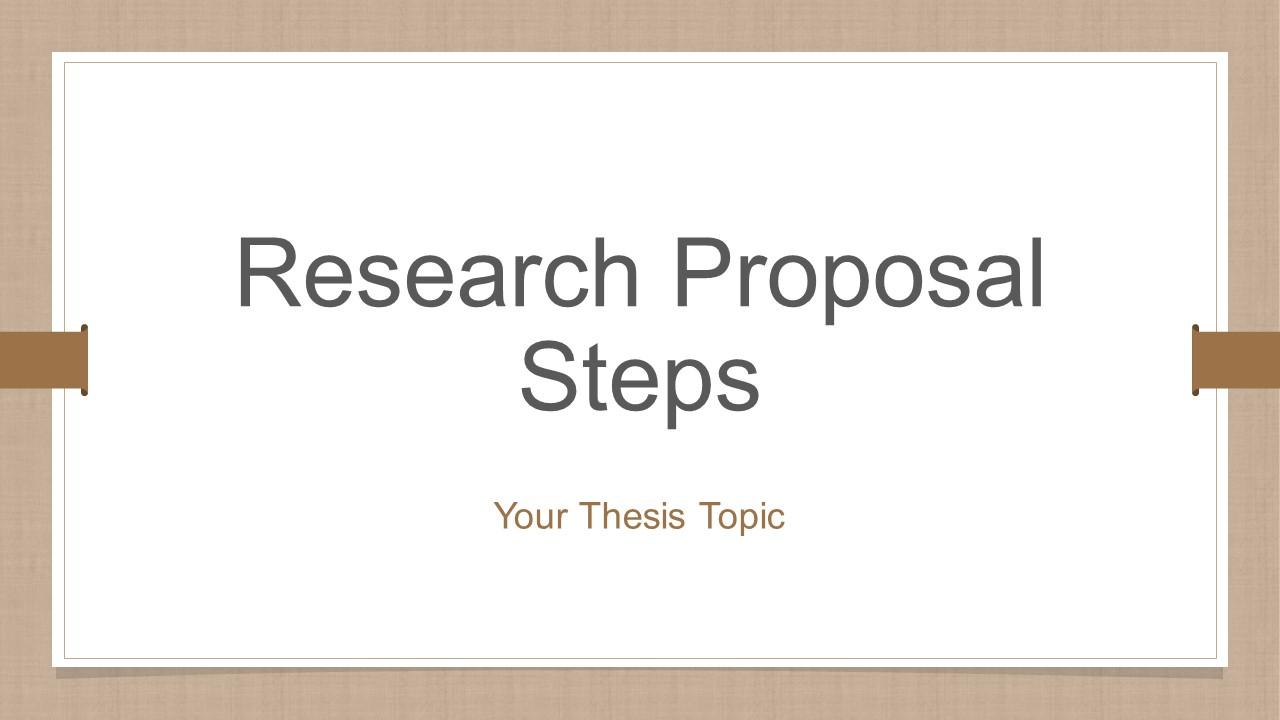
- Add a user to your subscription for free
You must be logged in to download this presentation.
PowerPoint presentation slides
Easy manual editing option to alter PPT background, font, text etc. No pixelate problem comes even while projecting on wide screen. Ready to use for students, teachers, consultants, project planners etc. Complete pre built set of 29 presentation slides. Freely insert text, title, logo, animation or videos as per requirement. Works well with all modern software's. Short downloading process triggers with just a click. The stages in this process are parallel computation thesis, dissertation defense, compilation thesis, grey literature, comprehensive examination, doctoral thesis, masters thesis, bachelors thesis, phd thesis.

People who downloaded this PowerPoint presentation also viewed the following :
- Themes , Training , Education , Flat Designs , Complete Decks , All Decks , Steps , Proposals , Research Proposal , Proposal
- Parallel Computation Thesis ,
- Dissertation Defense ,
- Compilation Thesis ,
- Grey Literature ,
- Comprehensive Examination ,
- Doctoral Thesis ,
- Masters Thesis ,
- Bachelors Thesis ,
Content of this Powerpoint Presentation
If you’ve drafted a research proposal, you must be aware of the rigor and effort required. Sleepless nights, struggles to find inspiration, and living off caffeine for days.
For students, researchers, and writers, drafting a research proposal from scratch is intimidating. To complete their professional degrees or to get funded for sponsored research projects, these proposals are crucial.
A research proposal is a detailed plan outlining the objectives, methodology, and expected outcomes of a research project. Typically, researchers, academics, or graduate students write these to seek funding or approval to conduct their research. Research proposals serve to communicate the significance of the study, demonstrate the feasibility of the research plan, and secure resources or institutional support. They are essential for gaining funding, academic approval, or collaboration opportunities for research endeavors.
The primary audience of these research proposals are academic advisors, instructors, funding agencies or institutions. Therefore, the proposal should be tailored to an academic audience with expertise in the relevant field of study.
With industry experts reviewing your proposal, you wouldn't wanna miss a chance to impress them. SlideTeam experts have prepared an Academic Proposal Template to help you with laying a strong foundation for your research paper. The 100% customizable nature of the template provides you with the desired flexibility to edit your presentations. The content-ready slides give you a structure to get started.
Template 1: Abstract
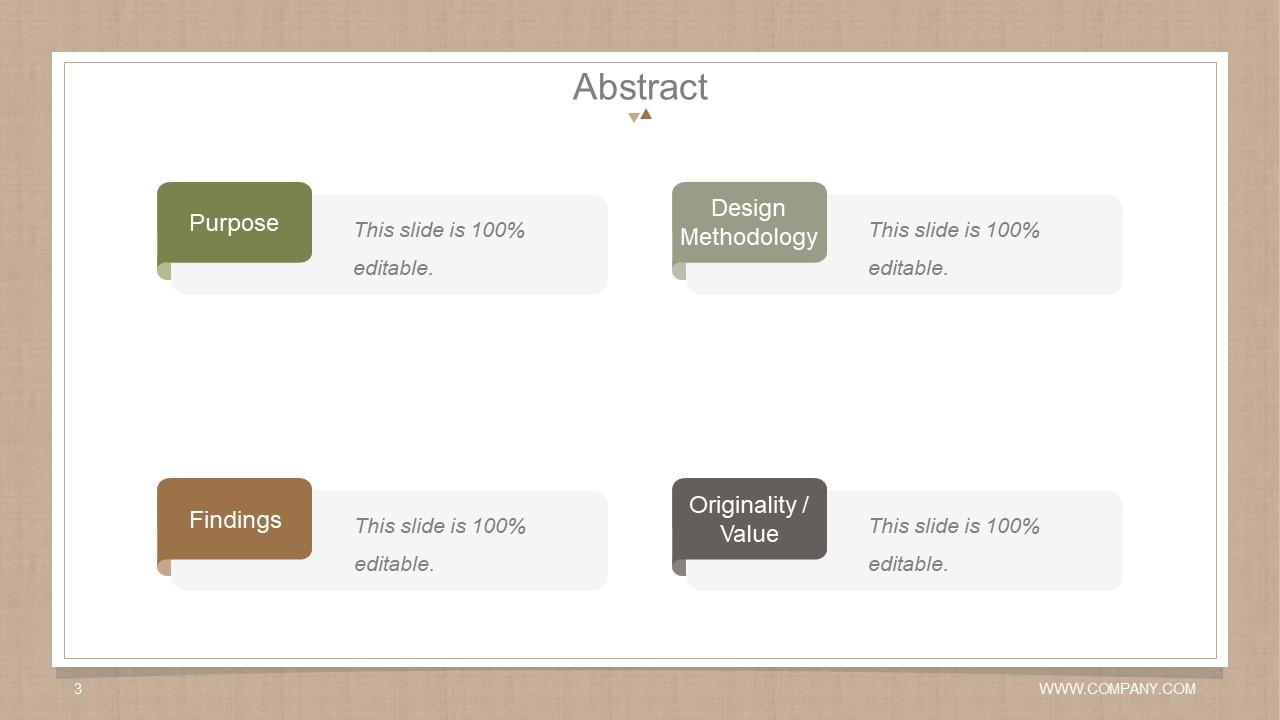
This PPT Template allows you to prepare the foundation for your research proposal. Compile your opening thoughts in the slide. The purpose section of the research project will highlight the intent and aim. Use the design methodology to list the approaches that you plan to use while carrying out the research. Write down the factors and variables in which the findings will be compiled. In the last column, originality/value, write the sources of data, a brief of references and credits.
Template 2: Introduction
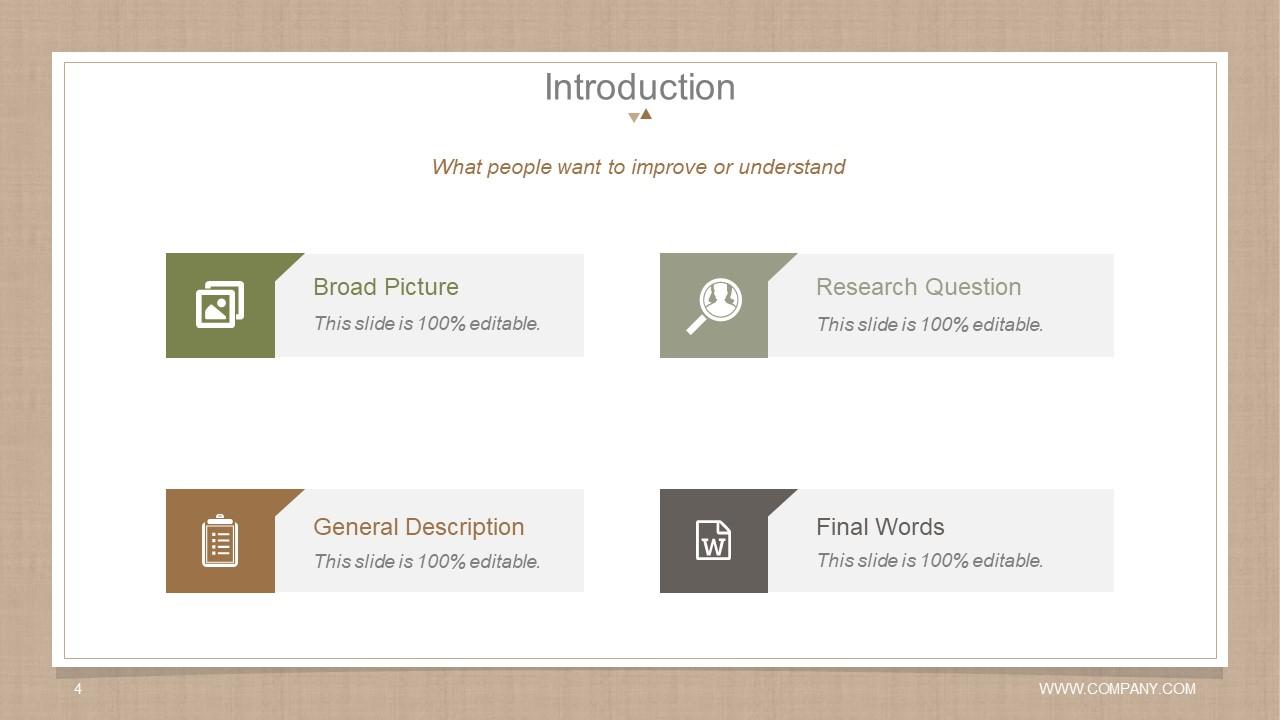
This Slide helps you to give your readers an overview of your research project. Start off by giving a broad picture of your research hypothesis in the first column. In one line mention your research question, this is the core idea of your work. The general description will include the brief elements of your argument and sources of evidence. The final words are the closing ideas, quantitative and qualitative results, and the research conclusion. You can insert information into each section in bullet points for enhanced clarity.
Template 3: Thesis Statement
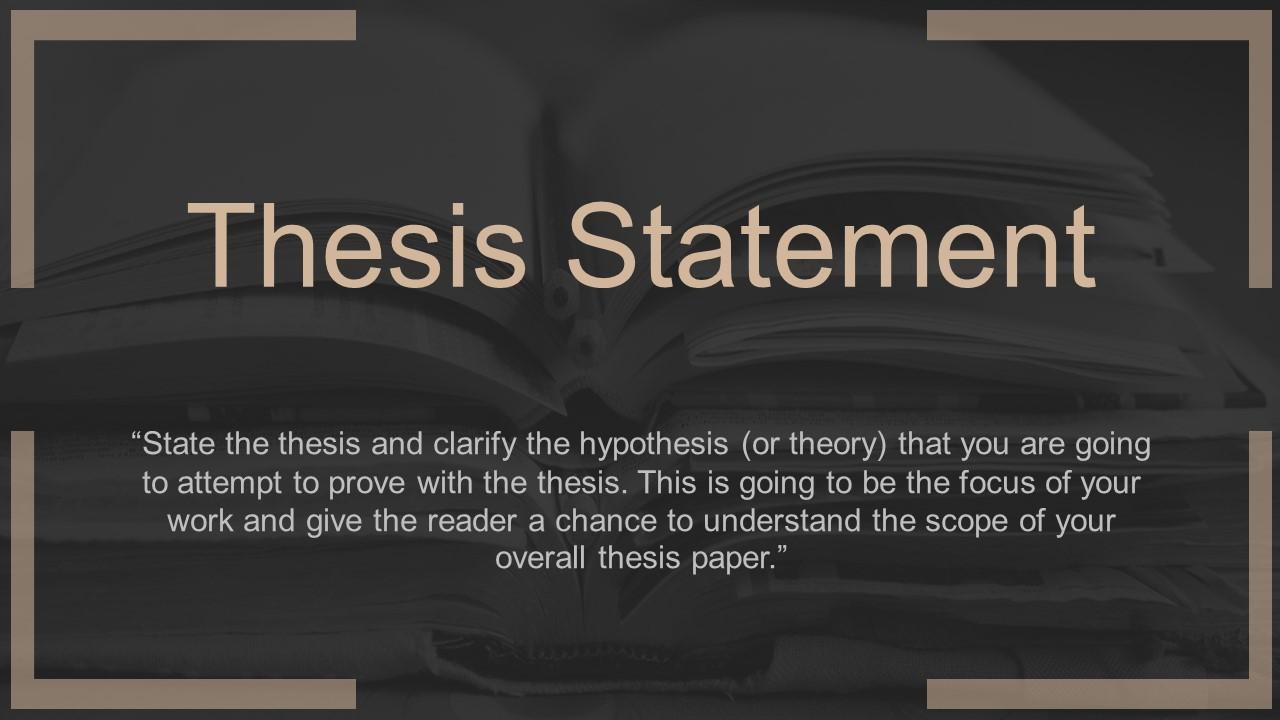
A thesis statement summarizes the central argument of an essay or research paper. Be sure to include the topic of discussion, your position or claim on the topic, the supporting evidence or reasoning, and the scope or parameters of the argument in the PPT Layout. This statement slide will serve as a roadmap for the reader, guiding them through the main points and focus of your research paper. Write a concise statement to capture the reader's attention.
Template 4: Methods or Approach
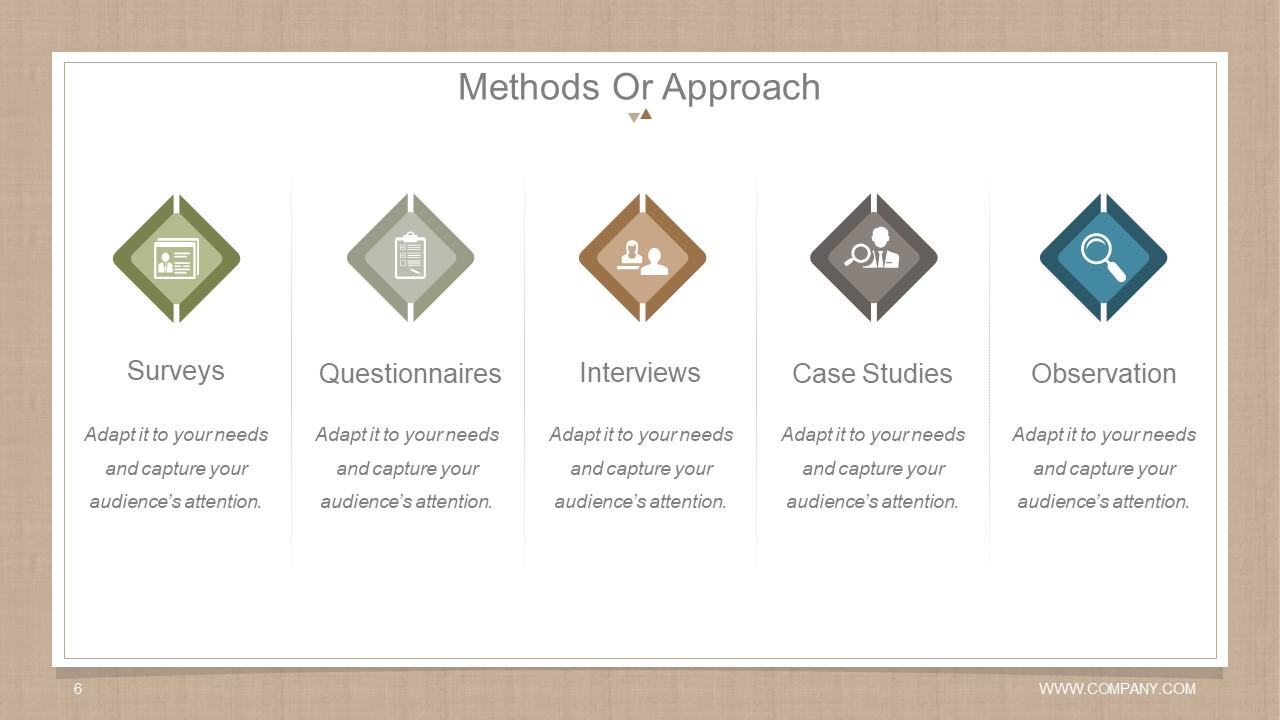
When it comes to conducting thorough research, it's crucial to have a unique and detailed approach. The research method is a strategic plan that outlines specific techniques and procedures to gather, analyze, and interpret data. This layout helps you plan your research approach or methods you will adopt, like surveys, questionnaires, interviews, case studies, and observations. As this data is crucial for the proposal you should follow a systematic approach towards gathering data, and use this PPT Template to do it well.
Template 5: Preliminary Discussion and Results
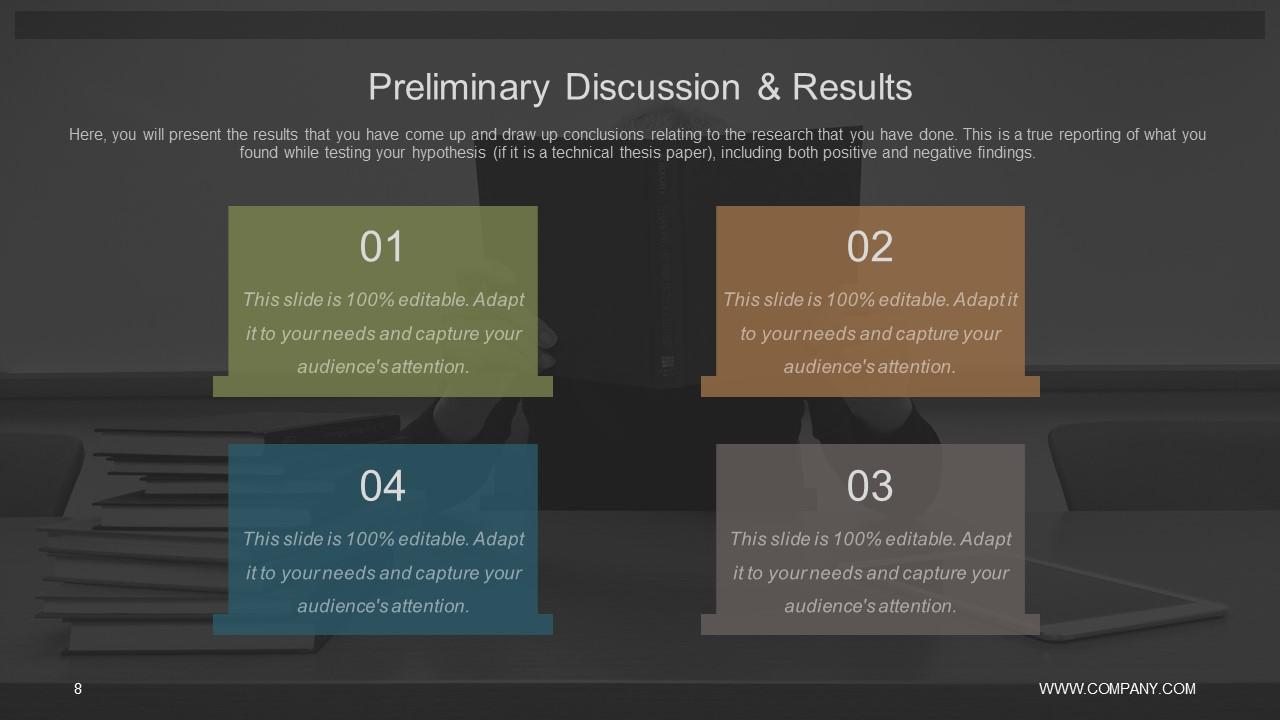
The template compiles information on two areas; the preliminary discussion and the results. The former section focuses on outlining the research conducted, including the hypothesis being tested. Whereas the next section can be used to present the findings of the research, including both positive and negative outcomes. This template offers a clear and concise way to communicate research progress and findings. You can present up to four key ideas.
Template 6: Work Plan With Timetable Template with Activities and Month
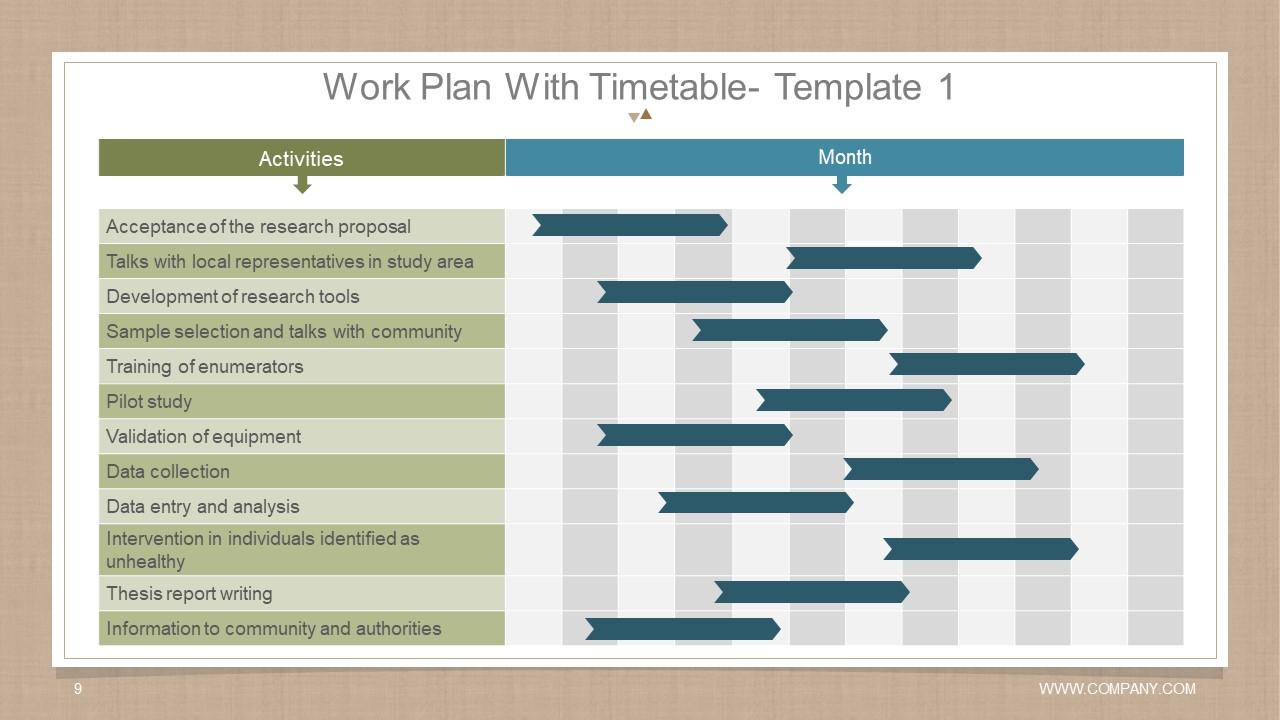
Before writing your research proposal, it is vital to map out an action plan on how to stay on track and build a strong foundation. With this Work Plan PPT Template, you can use the chart to map out activities like the acceptance of the research proposal, connecting with locals in the study area, developing research tools, sample selection, data collection, report writing etc. Use the arrows provided in the slide to mark the tentative time span and the month in which the action will take place. Plan your monthly, weekly, or daily activities with the table provided.
Template 7: Work Plan Timetable Template with Weekly Activities
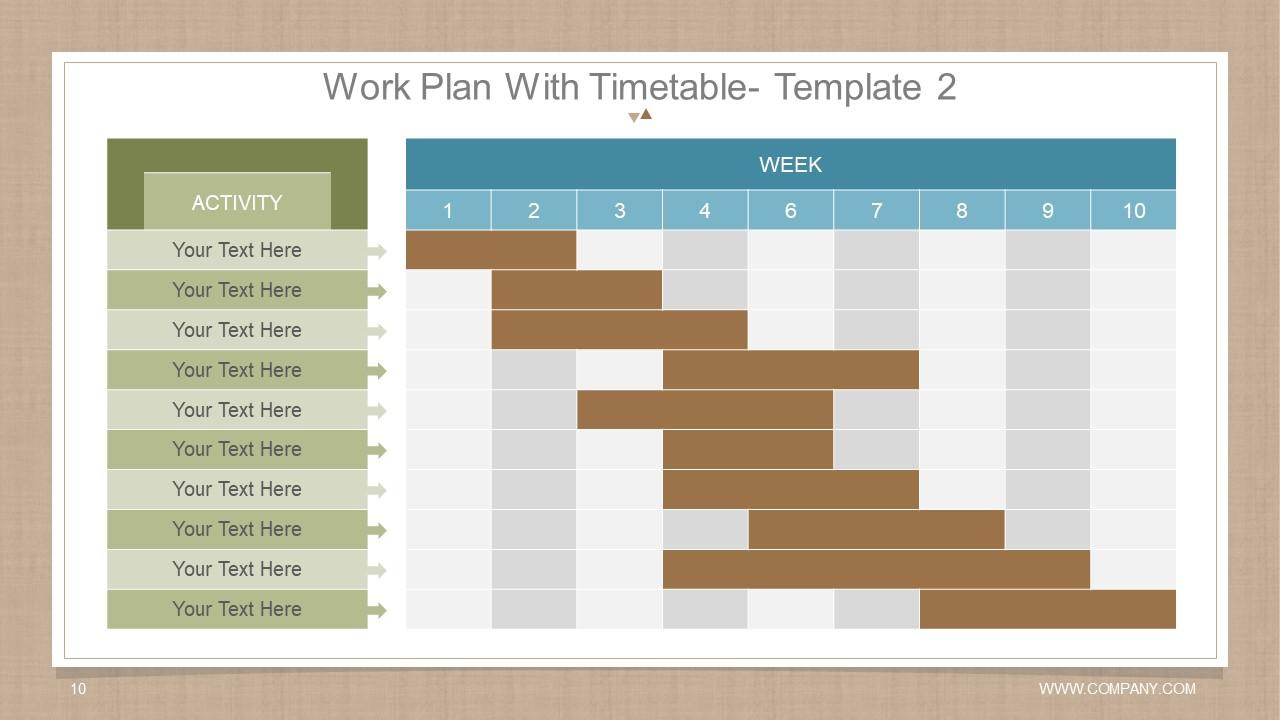
This PPT Deck offers you multiple formats to prepare a work plan timetable. This Gantt Chart Template enables you to present your action plan in a clear and concise manner. You can list down all the steps involved in drafting your research proposal. You can use the format to make a weekly or a monthly work plan. Based on this chart, you can prepare detailed action plans and manage your resources.
Template 8: Work Plan Timetable Template with Seven Stages and Time Frame
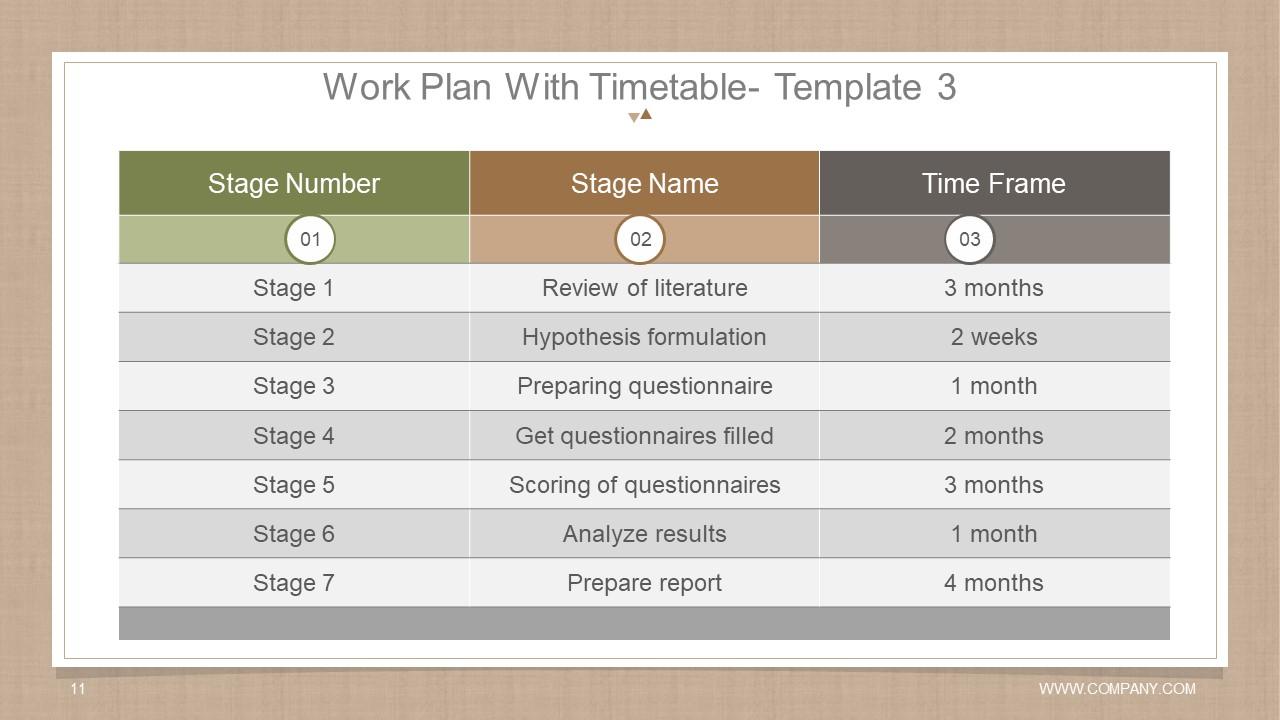
Use this slide to prepare a workplan in a tabular format. Categorize activities involved in preparing a research proposal into stages. Write a brief description of each stage in the second column of the table. Use the column provided in the slide to mention the tentative time frame of the stage. This will showcase your readiness and commitment towards the research project to your academic advisors or funding agents.
Template 9: Implication of Research
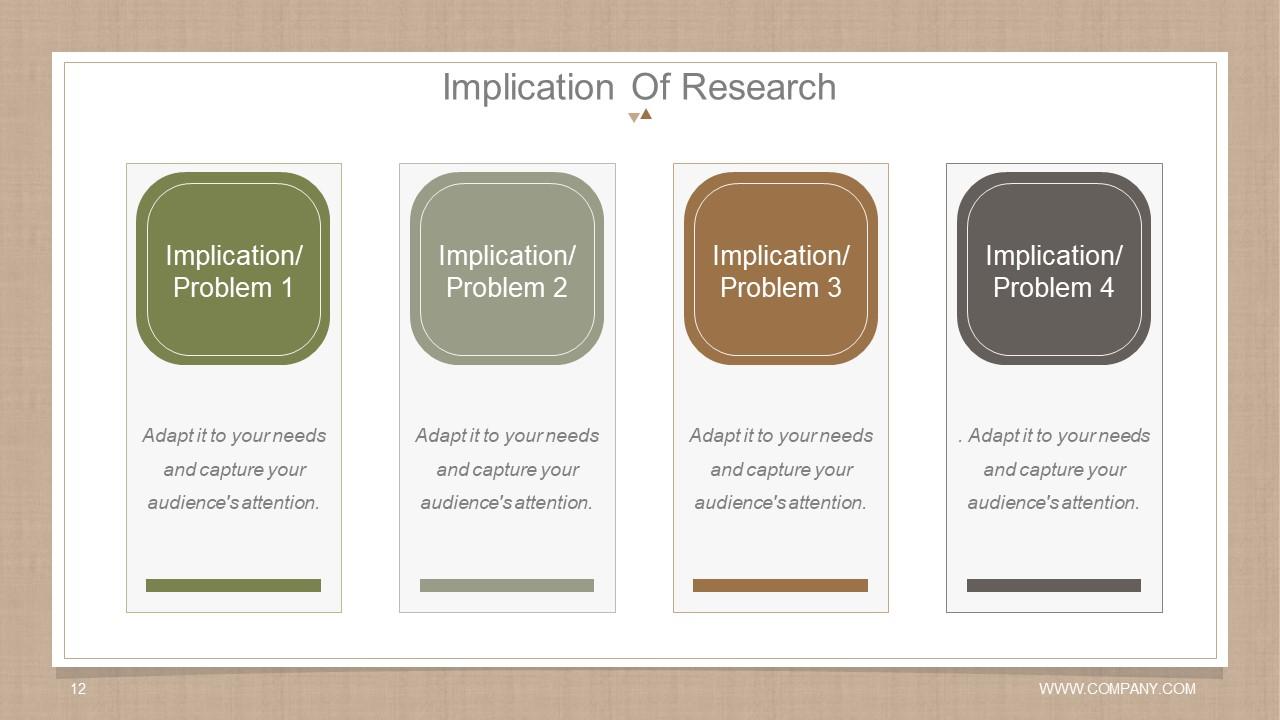
The template on implications of research refers to the potential consequences or applications of its findings in practical, theoretical, or societal contexts. These should be included in research proposals to demonstrate the significance and relevance of the study's potential outcomes, guiding future actions and understanding. This PPT Template can record up to four potential implications or problems in your research. Based on this, you can make contingency plans and suggest methods to lower their impact on the project.
Template 10: List of References/Bibliography
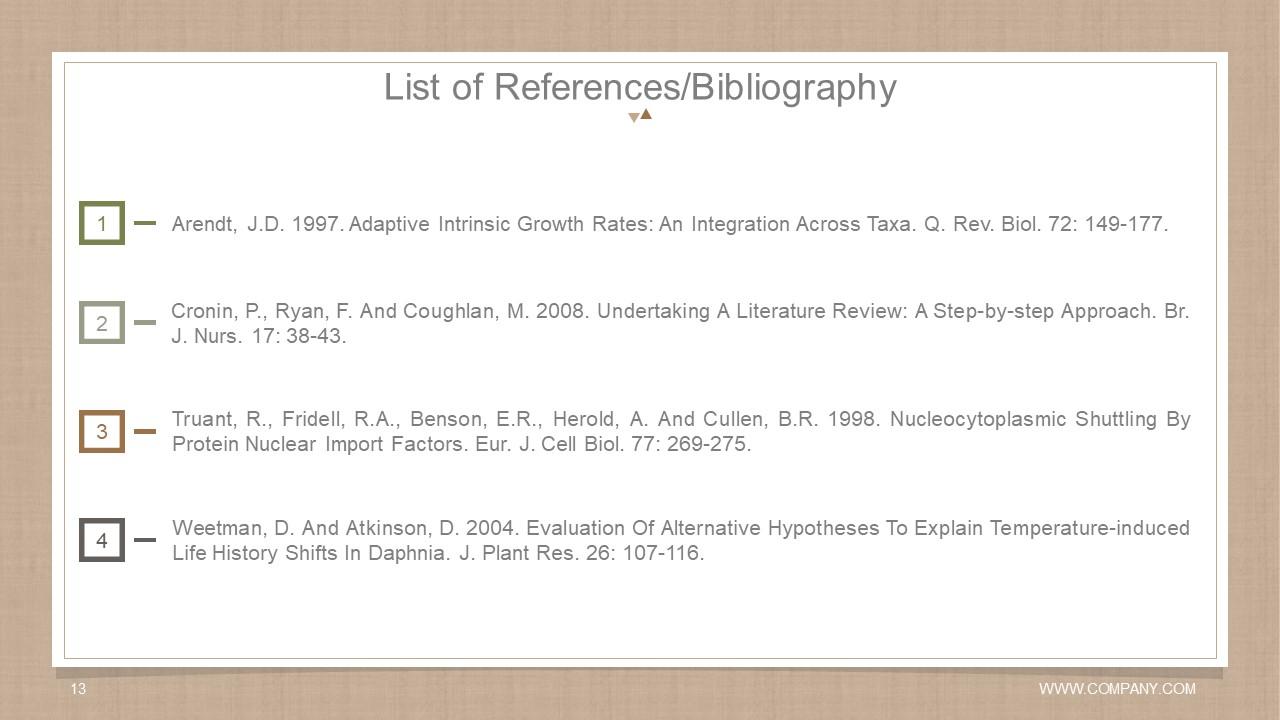
References establish the credibility of your work, demonstrate the knowledge of existing research, and provide a basis for your research's theoretical framework. Use this presentation template to list referencing conventions used in your academic proposal. Ensure that you cite both primary and secondary sources referred to in your research.
Ace your Research Proposals!
When creating an academic research proposal, it's crucial to present a well-structured, professionally crafted document with credible backing. Maintain consistency in formatting, adhere to citation guidelines, and provide a detailed list of credible sources. A polished proposal demonstrates your commitment and makes a strong case for your research's credibility, increasing the likelihood of approval and funding from academic committees or institutions.
You can streamline this process by using our content-ready research proposal PPT template, saving valuable time and effort. With this template, you can focus on the content of your proposal, allowing your ideas to shine through, while the template handles the visual part of the presentation and keeps the audience engaged.
Research proposal steps powerpoint presentation slides with all 29 slides:
Highlight the ingenuity of your creation with our Research Proposal Steps Powerpoint Presentation Slides. Elaborate on your invention.

Ratings and Reviews
by David Wright
June 5, 2021
by Daryl Silva


- PowerPoint Templates
15 Free Research Proposal PowerPoint Templates for Scientific Project, Thesis Defence
Are you a scientist who wishes to create a research proposal presentation in the best manner? If you do, then this excellent list of Research Proposal PowerPoint Templates is truly a demand!
The research proposal is a document that a researcher needs to write, It outlines the details of a research project and gives team members or readers a summary of the information in a project.
In order to allow readers to understand the project information more clearly, a research proposal presentation will be a better way to present the information of a research project.
A research proposal PPT should include the following:
- Research title or topic: make sure your title can clearly describe the research project, or supplement your research project with a short statement.
- Research background: why do this research project
- literature review: describe research progress on your research topic, and the gap or remaining questions need to research.
- Research aim, objective, and hypothesis
- Research method: explain how to conduct your research, how data is collected and analyzed.
- Results: the results you expect.
- Question: provides an overview of the problems encountered during the research process, and how to solve them.
- Summary: make sure the reader has a complete understanding of your research project.
Note: this PDF file made by Australian National University provides more information about the research proposal presentation.
In this collection, you’ll find numerous and diverse styles of research proposals ppt templates that you can pick as part of your inspiration.
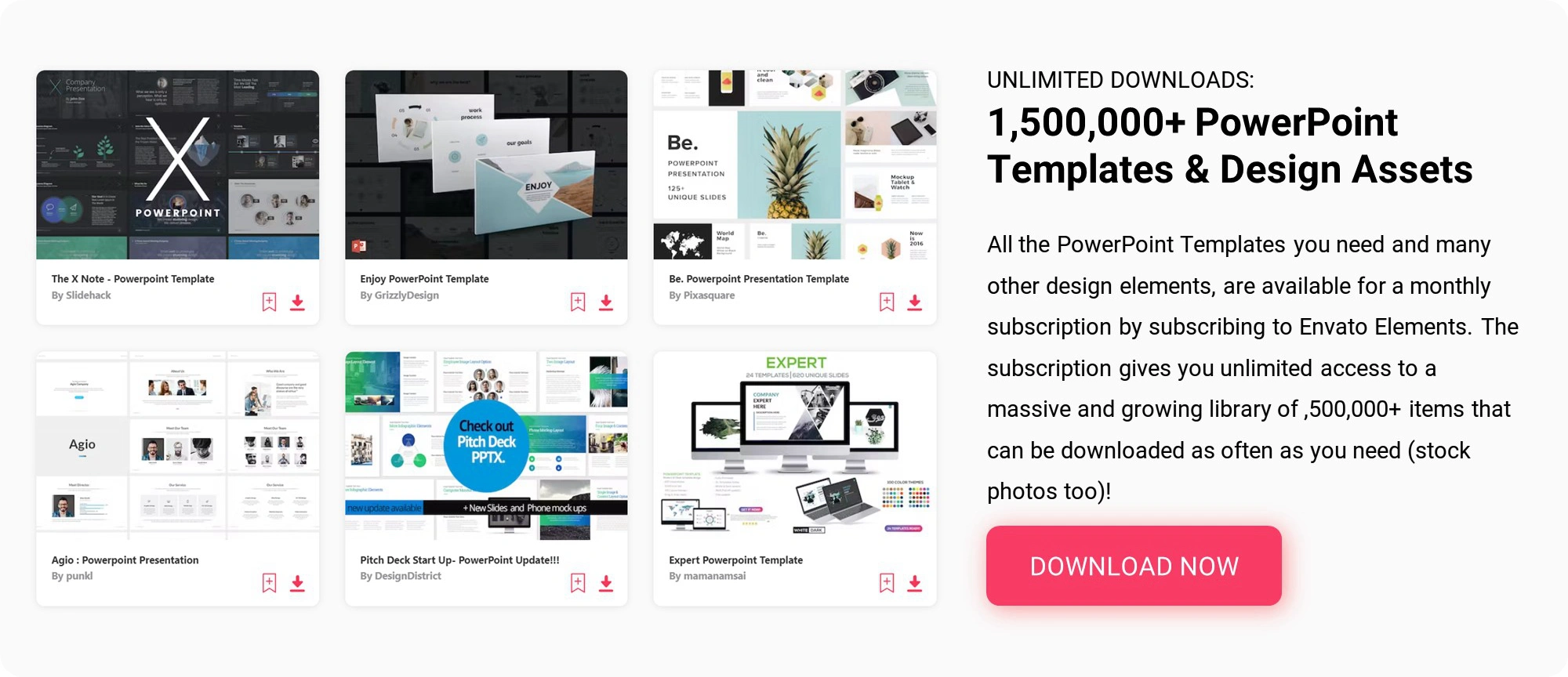
Table of Contents
Free research proposal powerpoint templates, premium research proposal powerpoint templates, 1. rea thesis presentation template.
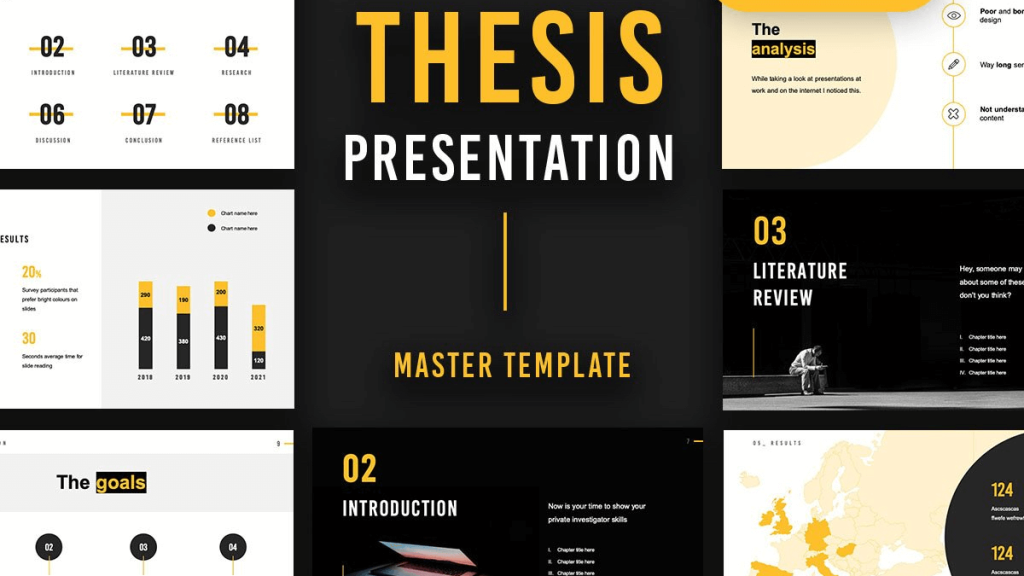
You can create a professional research proposal with Rea in a matter of minutes. Why? Because you don’t need any design knowledge or sophisticated design software like Photoshop or Adobe Illustrator, the Rea ppt template gives you everything you need to create a research proposal, it provides a complete pre-built slide set. What you need to do is focus on your study.
To assist you in presenting your research proposal in a structured way, the Rea template divides your research proposal into seven sections: introduction, literature review, research, results, discussion, conclusion, reference list. The majority of research proposals can follow this structure.
The Rea ppt template features a modern, creative design, the alternation of light slides and dark slides will attract the viewer’s attention well.
Unique slides: 33
2. Master Thesis Defense PowerPoint Template
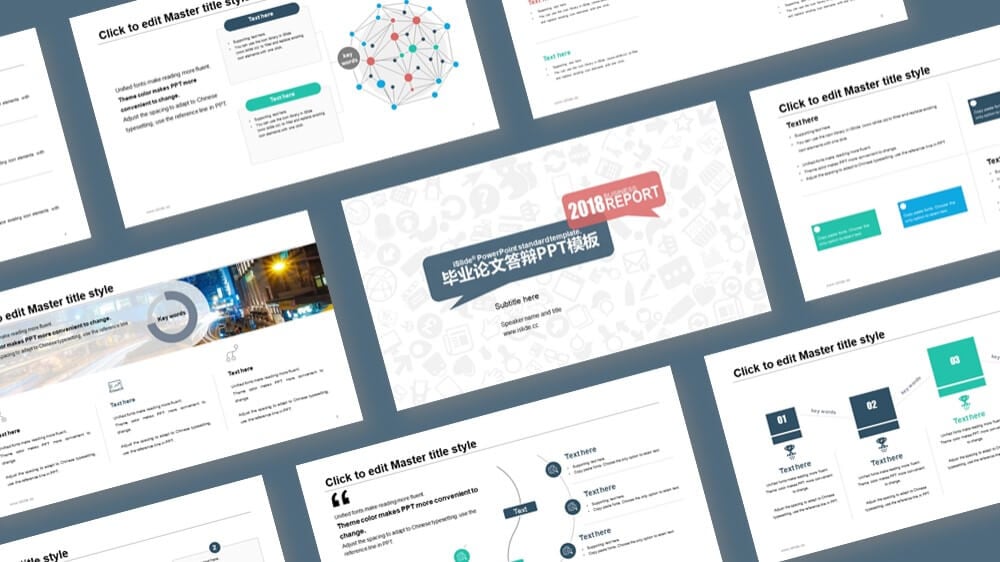
The Master Thesis Defense PowerPoint Template is a thesis PowerPoint presentation for students. It features a clean, sophisticated design, the unified layout allows you to easily adjust or add slides in your presentation. This template is perfect for a master’s thesis.
Unique slides: 21
3. Blue Graduation & Thesis Defense Presentation
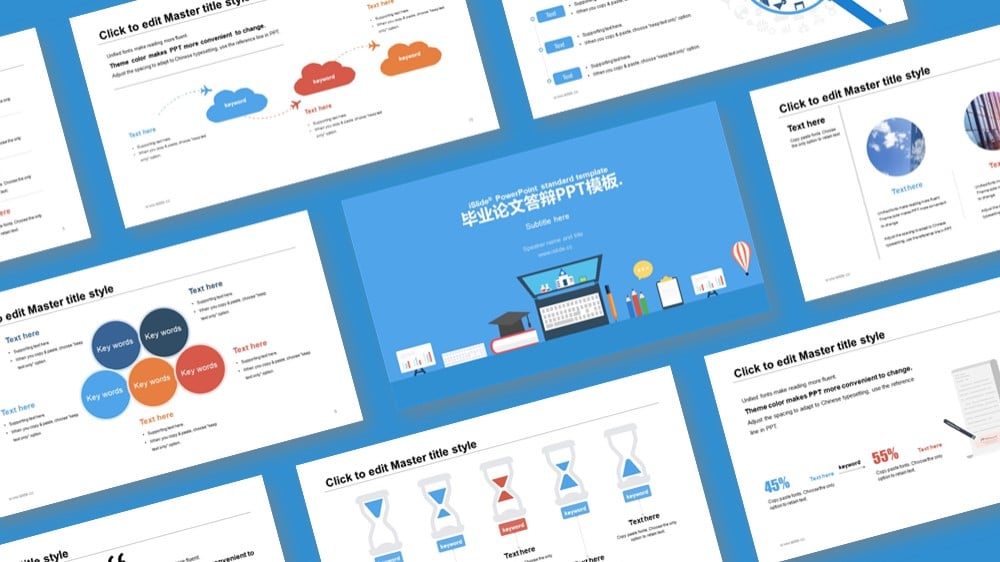
This PPT template is made for thesis defense presentations, such as bachelors thesis, PhD thesis, masters thesis, or doctoral thesis. It comes with a blue background cover slide and a lot of useful infographic slides.
4. Red Dissertation proposal defense powerpoint presentation

This research proposal PowerPoint template uses a striking red as the main color, features 21 editable slides. The table of contents slide and break slide will help you organize your content.
5. Green Dissertation defense presentation template

Green Dissertation defense presentation template comes with 21 unique slides and a clean layout, suited for chemistry thesis or biology thesis.
6. PhD Dissertation Defense Presentation Template

PhD Dissertation Defense Presentation Template features a clean, minimal design. It’s well organized and easy to use. The only thing you need to focus on is your research.
7. Blue Medical research proposal powerpoint template

Blue Medical is a free multipurpose PowerPoint template for medical presentations. This template is also perfect for medical research proposals, chemical project research proposals.
Unique slides: 41
8. Master’s Thesis Defense PowerPoint Template

Master’s Thesis Defense Free PowerPoint Template is one of the best research proposal templates. You don’t need to build anything from scratch, it’s more or less just a matter of dragging and dropping, editing text and charts.
Unique slides: 28
9. Research presentation Template

This PPT template is a simple alternative that helps you create a research slide. It includes 5 steps to guide you through the research process. If you want a simplest PowerPoint template, this will be the right one.
Unique slides: 9
10. Minerva Master Thesis Defense PowerPoint Template

Minerva is a free minimalist master’s thesis defense presentation template. It has 34 comprehensive and unique slides. Use this template to present your research now!
Unique slides: 34
11. Professional Thesis Project Proposal PowerPoint Template
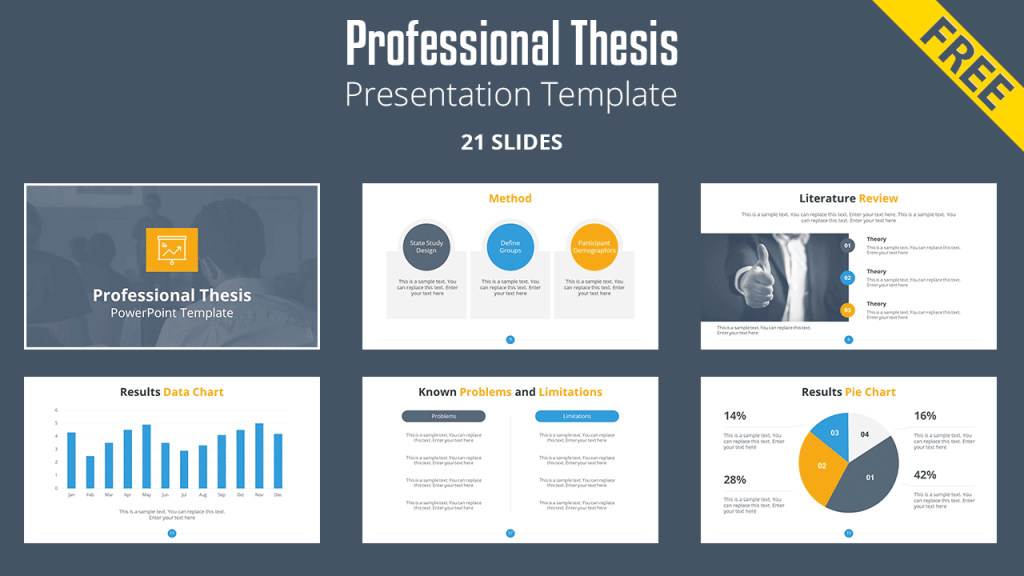
Professional Thesis Project Proposal PowerPoint Template is a free research paper ppt template. It comes with 21 easy-to-use slides that include every aspect of your thesis, from the purpose of your study to method, data analysis, results, and discussion.
12. Thesis Presentation Powerpoint & Google Slides Template
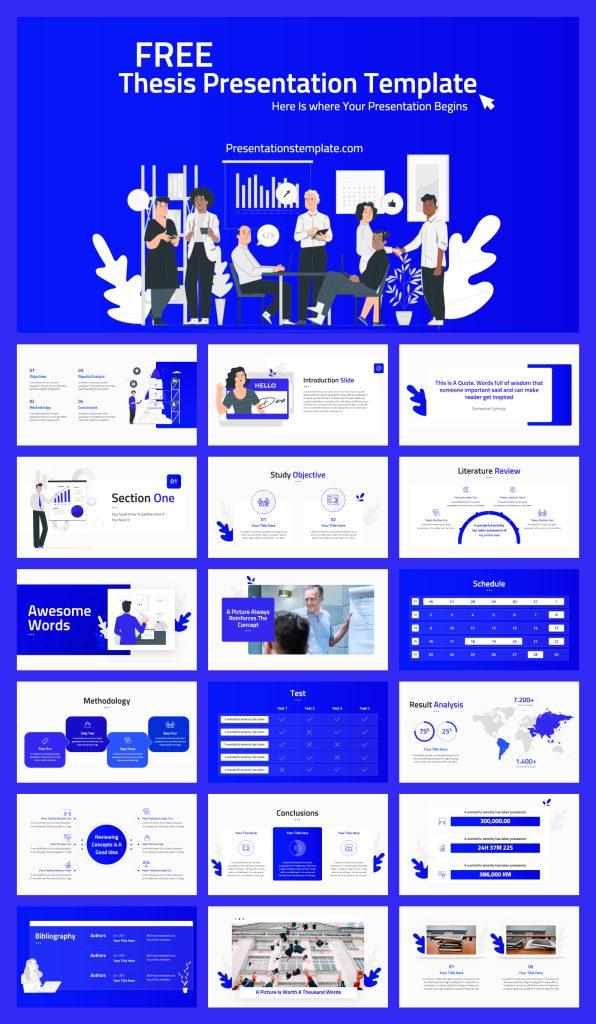
This presentation template is one of the best free research proposal ppt templates that help you stand out. It features 20 pre-built research slides with modern, minimal layouts.
13. The effects of technology learning Research Presentation Template

This cool presentation template is designed for students to present their school projects. It includes many illustrations and graphs.
14. Free Thesis Defense Presentation Template
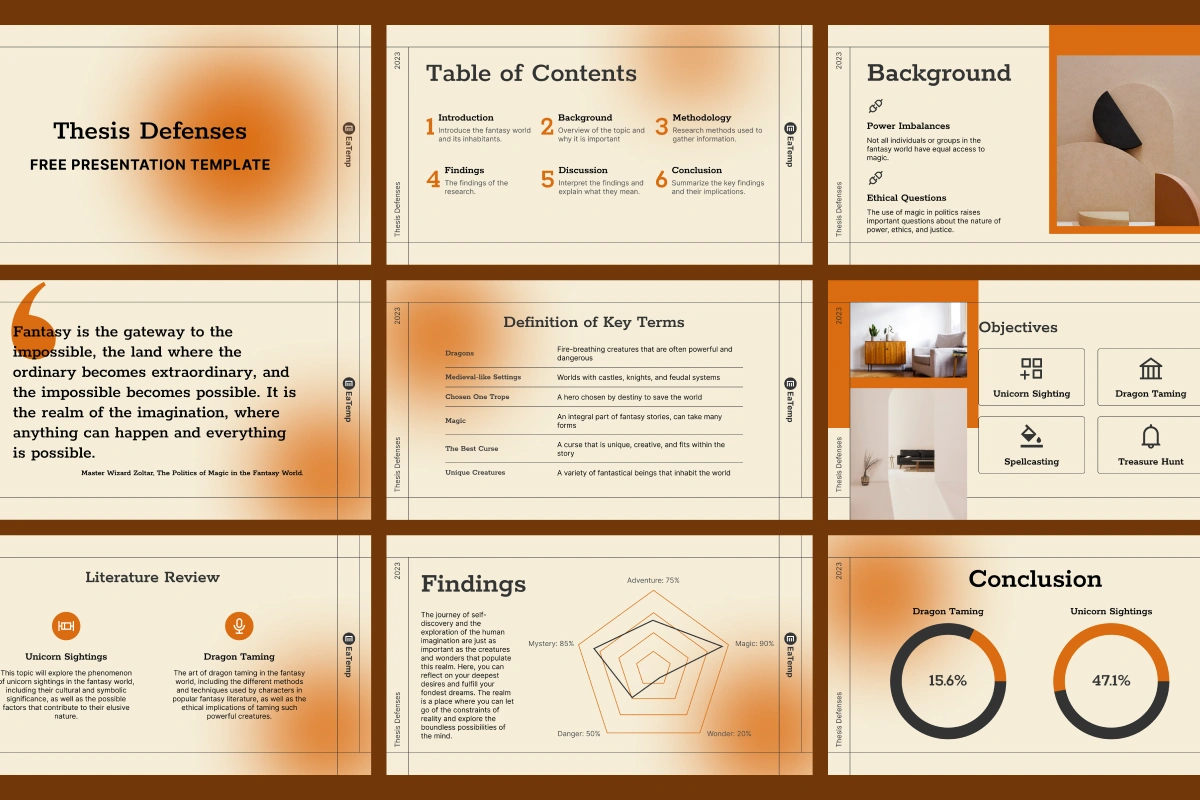
This beautiful PPT template is for anyone who needs a quick but professional thesis defense template. Utilize professionally designed slides for your introduction, methodology, results, and conclusion. The template includes 22 animated slides.
15. Black and white Research Proposal Presentation Free download

A free research proposal presentation template for PowerPoint and Google Slides, contains 29 unique slides.
16. Simple Research Proposal Presentation
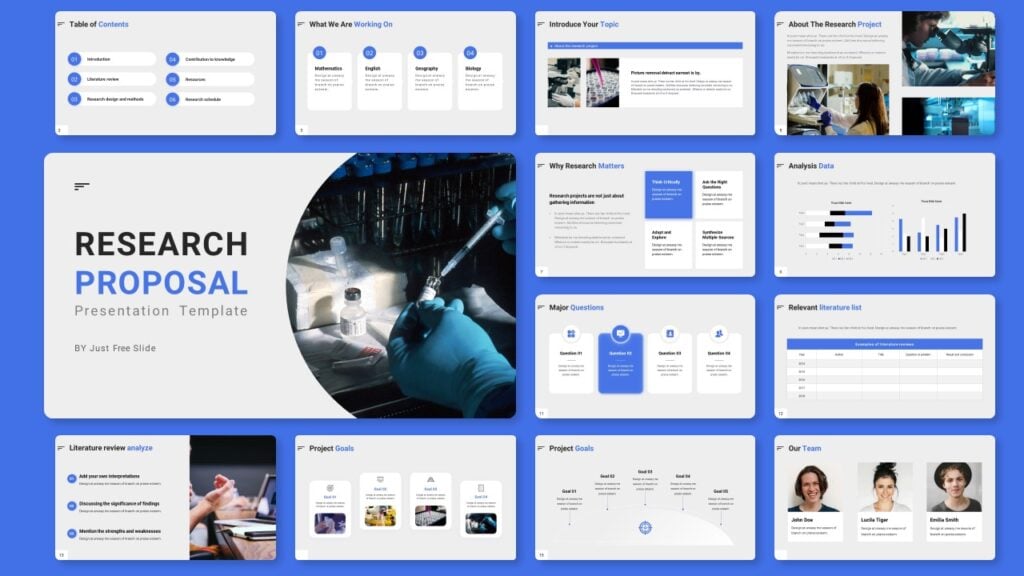
The template comes with a simple, minimal, and modern design. It would be perfect for any type of research proposal.
Thesis Science Powerpoint Template

Thesis Science Powerpoint Template offers 20 unique slides. All slides have been organized and categorized to adhere to the guidelines stipulated by the thesis defense format.
SOLOZ – Dark Background Science Thesis Defense Powerpoint Template
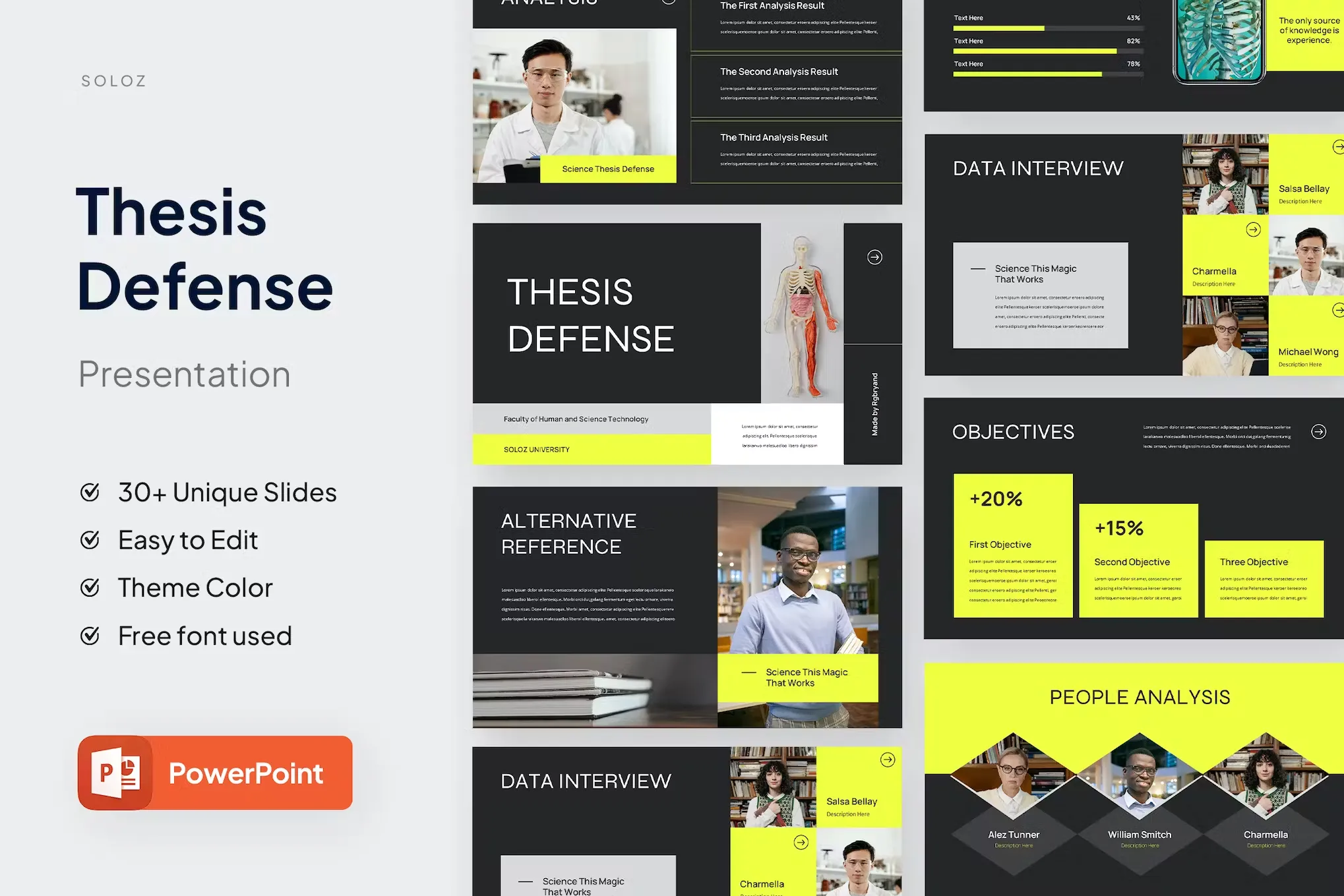
SOLOZ PPT template contains 30 unique slides with a dark background. The unified color scheme and master slides make it easy to customize and quickly build an impressive presentation.
Thesis Defense – Design Powerpoint Template

This thesis defense PowerPoint template uses a design interior theme as a preview. It comes with 30 unique slides, dark and light backgrounds, and widescreen & standard ratio.
Research Proposal PPT Template

The Research Proposal PowerPoint Template offers over 50 slide designs with a modern and professional look. This template is available in three various formats: PowerPoint, Google Slides, and Keynote.
Thank you for visiting Just Free Slide and reading this article! We hope this article helped you find the best research proposal PowerPoint template. We highly appreciate it! Now you might want to get more free PowerPoint templates . Below you’ll find more PowerPoint templates related to the research proposal:
- 8 Best Academic PowerPoint Templates
- 42 Pages Thesis Defense PowerPoint Presentation Template (Premium)
More like this
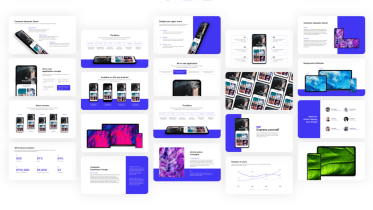
Wonderful article! I have found an amazing site on Google it’s http://www.kridha.net . Here you can explore professionally designed fully customizable research templates which are easy to use.
Leave a Reply Cancel reply
Your email address will not be published. Required fields are marked *
Got any suggestions?
We want to hear from you! Send us a message and help improve Slidesgo
Top searches
Trending searches

welcome back to school
111 templates
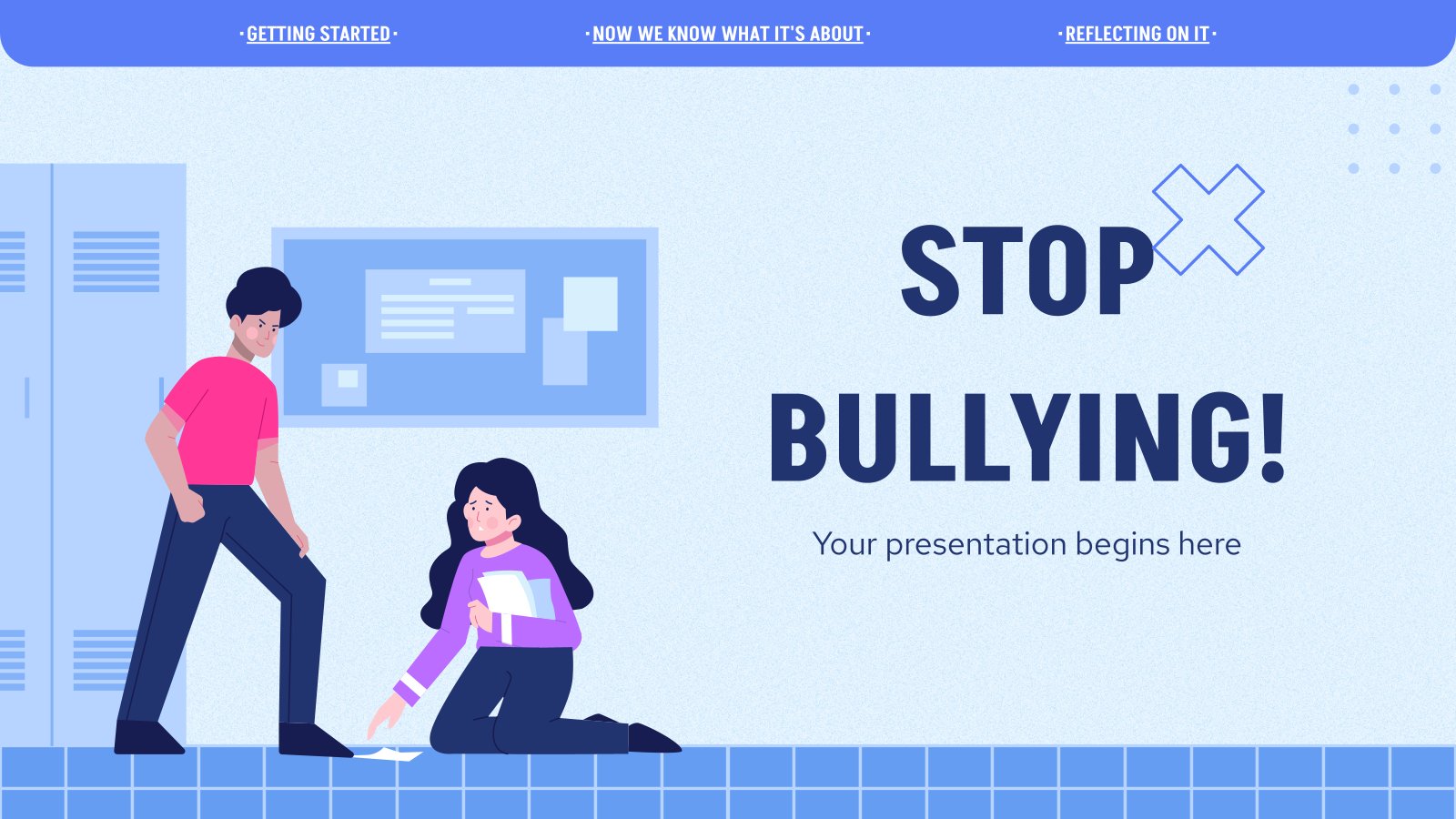
stop bullying
11 templates

sunday school
65 templates

first day of school
69 templates

team introduction
23 templates

94 templates
Research Project Proposal
It seems that you like this template, research project proposal presentation, premium google slides theme, powerpoint template, and canva presentation template.
Before embarking yourself on a new project, especially if it’s about research, you need to set out a proposal to explain its viability. Here at Slidesgo we’re offering this theme that you can actually use for any kind of project, regardless of the topic.
We’ve designed this template very carefully so that it can work in any context. For example, our flat illustrations, while visually appealing, show generic business situations, so versatility is on your side. The white backgrounds contain various gray objects on top of them as decorative elements, such as windows or filing cabinets. Our customizable layouts are useful for displaying things like project goals, results, timelines and mockups. The graphic resources and the typography focus on the green and dark blue colors, which are always synonyms for security and growth. Ready to edit this versatile business template?
Features of this template
- A versatile business template with flat illustrations related to a generic office context
- 100% editable and easy to modify
- 26 different slides to impress your audience
- Available in six colors: green, pink, purple, blue, yellow, and red
- Contains easy-to-edit graphics and maps
- Includes 500+ icons and Flaticon’s extension for customizing your slides
- Uses illustrated concepts from Storyset : editable color, different backgrounds, animated illustrations
- Designed to be used in Google Slides, Canva, and Microsoft PowerPoint
- 16:9 widescreen format suitable for all types of screens
- Includes information about fonts, colors, and credits of the free and premium resources used
What are the benefits of having a Premium account?
What Premium plans do you have?
What can I do to have unlimited downloads?
Combines with:
This template can be combined with this other one to create the perfect presentation:

Don’t want to attribute Slidesgo?
Gain access to over 28900 templates & presentations with premium from 1.67€/month.
Are you already Premium? Log in
Available colors
Original Color

Register for free and start downloading now
Related posts on our blog.

How to Add, Duplicate, Move, Delete or Hide Slides in Google Slides

How to Change Layouts in PowerPoint

How to Change the Slide Size in Google Slides
Related presentations.

Premium template
Unlock this template and gain unlimited access

Register for free and start editing online
An official website of the United States government
Here's how you know
Official websites use .gov A .gov website belongs to an official government organization in the United States.
Secure .gov websites use HTTPS. A lock ( Lock Locked padlock ) or https:// means you've safely connected to the .gov website. Share sensitive information only on official, secure websites.
A Dear Colleague Letter (DCL) is an informal correspondence which is written by a Requesting Office and distributed to communities within a specific program area, to attract individuals eligible under a Visiting Scientist, Engineer, and Educator (VSEE) appointment, an Intergovernmental Personnel Act (IPA) assignment and/or a Federal Temporary appointment. These letters may be circulated in paper form through internal mail, distributed electronically using listservs or accessed through NSF.gov’s Career Page.
Program Director
Application timeline, position summary.
The Historically Black Colleges and Universities-Excellence in Research (HBCU-EiR) program within the Research and Capacity Section (RCC) in the Office of Integrative Activities (OIA) under the Office of the Director, announces a nationwide search to fill a rotator Program Director position. The RCC section supports the development and enhancement of science, technology, engineering, and mathematics (STEM) research capacity by helping individuals and teams develop abilities to perform research effectively, efficiently, and in a sustainable manner. The HBCU-EiR program builds on continuing efforts by the U.S. National Science Foundation (NSF) to strengthen research capacity at HBCUs. EiR supports such capacity building by funding research projects aligned with NSF’s research programs.
Position Description
NSF Program Directors have the primary responsibility for carrying out the Agency's overall mission to support innovative activities in fundamental research and education that contribute to the nation's technological strength, security, and welfare. This responsibility includes ensuring that proposed activities receive expert, fair merit review. Program Directors are also responsible for service in support of other NSF-wide activities and initiatives that together accomplish NSF's strategic goals, to: 1) Expand knowledge in science, engineering, and learning, 2) Advance the capability of the Nation to meet current and future challenges, and 3) Enhance NSF's performance of its mission.
In support of these goals, NSF Program Directors are responsible for extensive interaction with the research community and other stakeholders including industry and other Federal agencies. Within this context, Program Directors solicit, receive, and review research and education proposals, make funding recommendations, administer awards, and undertake interaction with research communities in these fields. This requires expertise in appropriate disciplines to implement the proposal review and evaluation process for the program, as well as strong skills in written and oral communication. Successful candidates should be receptive to new ideas, have a strong sense of fairness, excellent judgment, and a high degree of personal integrity.
The Program Director in EPSCoR will have specific responsibilities that may include the following:
- Participating in technical management and financial oversight of the HBCU-EiR program.
- Establishing goals and objectives, initiating new program thrusts, revising current activities and potentially phasing out some programmatic areas.
- Providing information on new developments and opportunities in STEM.
- Maintaining and further strengthening linkages with collaborative programs at NSF and other relevant Federal agencies.
- Managing an effective and timely merit review process.
- Representing the HBCU-EiR program at relevant internal and external events.
- Keeping abreast of current research and educational trends.
- Participating in some defined subset of professional activities that contribute to such currency (e.g., conducting research, delivering presentations and publishing quality scholarship, attending technical conferences of relevance, reading scientific articles and books and engaging in other forms of ongoing professional development).
- Working cooperatively across Divisions, Directorates, and the Foundation, and with other agencies to accomplish the mission of NSF.
Appointment options
The position recruited under this announcement will be filled under the following appointment option(s):
Intergovernmental Personnel Act (IPA) Assignment: Individuals eligible for an IPA assignment with a Federal agency include employees of State and local government agencies or institutions of higher education, Indian tribal governments, and other eligible organizations in instances where such assignments would be of mutual benefit to the organizations involved. Initial assignments under IPA provisions may be made for a period up to two years, with a possible extension for up to an additional two-year period. The individual remains an employee of the home institution and NSF provides the negotiated funding toward the assignee's salary and benefits. Initial IPA assignments are made for a one-year period and may be extended by mutual agreement.
Eligibility information
It is NSF policy that NSF personnel employed at or IPAs detailed to NSF are not permitted to participate in foreign government talent recruitment programs. Failure to comply with this NSF policy could result in disciplinary action up to and including removal from Federal Service or termination of an IPA assignment and referral to the Office of Inspector General. https://www.nsf.gov/careers/Definition-of-Foreign-Talent-HRM.pdf .
Applications will be accepted from U.S. Citizens. Recent changes in Federal Appropriations Law require Non-Citizens to meet certain eligibility criteria to be considered. Therefore, Non-Citizens must certify eligibility by signing and attaching this Citizenship Affidavit to their application. Non-Citizens who do not provide the affidavit at the time of application will not be considered eligible. Non-Citizens are not eligible for positions requiring a security clearance.
To ensure compliance with an applicable preliminary nationwide injunction, which may be supplemented, modified, or vacated, depending on the course of ongoing litigation, the Federal Government will take no action to implement or enforce the COVID-19 vaccination requirement pursuant to Executive Order 14043 on Requiring Coronavirus Disease 2019 Vaccination for Federal Employees. Federal agencies may request information regarding the vaccination status of selected applicants for the purposes of implementing other workplace safety protocols, such as protocols related to masking, physical distancing, testing, travel, and quarantine.
Qualifications
Candidates must have (1) a Ph.D. in any field of science or engineering supported by NSF, plus after award of the Ph.D., six or more years of successful research, research administration, and/or managerial experience pertinent to the position; OR (2) a Master's degree in any field of science or engineering supported by NSF, plus after award of the Master's degree, eight or more years of successful research, research administration, and/or managerial experience pertinent to the position.
The selected candidate is expected to function effectively as a member of crosscutting, fast-paced, and interactive teams and have a strong interest in advancing the research frontier. In addition, NSF is seeking candidates with experience in roles related to either the development and management of research infrastructure implementation projects at HBCUs or the successful leadership of multi-disciplinary, multi-institutional collaborations at HBCUs. Experience in interacting, leading, or working with researchers from a wide range of disciplines and leading, building or facilitating the formation of teams to address complex research problems is of particular interest. As noted above, the position requires effective oral and written communication skills and a commitment to high standards of ethical conduct. The position also requires a considerable breadth of interest, receptivity to new ideas, a strong sense of fairness, attention to detail, good judgment and a high degree of personal integrity. The candidate must also demonstrate the capability or potential to successfully engage external stakeholders through outreach to promote NSF activities, foster the inclusion of groups who are underrepresented in STEM, and to leverage program funds through internal and external collaborations.
How to apply
To apply, email a single PDF document that includes: 1) a cover letter detailing interest in the position, 2) a curriculum vitae (CV), and 3) a Citizen Affidavit, if applicable. The cover letter should describe how your experiences fit with the position of an HBCU-EiR Program Director (referencing the CV).
It is preferred that application materials and questions be sent to the Office of Integrative Activities DCL Inquiries via email to [email protected] with "HBCU-EiR Program Director" in the subject line.

IMAGES
VIDEO
COMMENTS
Keep to your written proposal formula. You need a title slide (with your name, that of your advisor & institution) Several slides of introduction. that put your study into the big picture. explain variables in the context of existing literature. explain the relevance of your study organisms. give the context of your own study.
Presentations with strong narrative arcs are clear, captivating, and compelling. Orient the audience and draw them in by demonstrating the relevance and importance of your research story with strong global motive. Provide them with the necessary vocabulary and background knowledge to understand the plot of your story.
In the case of a research presentation, you want a formal and academic-sounding one. It should include: The full title of the report. The date of the report. The name of the researchers or department in charge of the report. The name of the organization for which the presentation is intended.
Visualize Data Instead of Writing Them. When adding facts and figures to your research presentation, harness the power of data visualization. Add interactive charts and graphs to take out most of the text. Text with visuals causes a faster and stronger reaction than words alone, making your presentation more memorable.
Template 1: Clinical Research Trial PowerPoint Template. Use this premium PPT template to captivate your audience. Download this well-created template to raise your presenting threshold. Establish your milestones with workflows designed to ease the overburdening of tasks.
Research Proposal Presentation Tips - Staff Services - ANU
Research proposal examples. Writing a research proposal can be quite challenging, but a good starting point could be to look at some examples. We've included a few for you below. Example research proposal #1: "A Conceptual Framework for Scheduling Constraint Management".
Here are some simple tips for creating an effective PowerPoint Presentation. Less is more: You want to give enough information to make your audience want to read your paper. So include details, but not too many, and avoid too many formulas and technical jargon. Clean and professional: Avoid excessive colors, distracting backgrounds, font ...
A WORD Studio guide to presenting your research. I. The Research Proposal Presentation. The overall purpose of a research proposal presentation is inquiry: you're sharing what you've learned so far and how you hope to develop it so that you might hear from others what questions they have, where they felt confused, and new directions they ...
Make sure you can ask the critical what, who, and how questions of your research before you put pen to paper. Your research proposal should include (at least) 5 essential components : Title - provides the first taste of your research, in broad terms. Introduction - explains what you'll be researching in more detail.
Let's move on and discover how to make research proposal presentation. 4 Steps to Create a Great Thesis Proposal Presentation. When you present your project, you literally sell it to the officials, proving its value and importance within the whole field. That's why it's essential to consider valuable points when working on the project.
Step 1: Title and Abstract. Select a concise, descriptive title and write an abstract summarizing your research question, objectives, methodology and expected outcomes . The abstract should include your research question, the objectives you aim to achieve, the methodology you plan to employ and the anticipated outcomes.
Here is an explanation of each step: 1. Title and Abstract. Choose a concise and descriptive title that reflects the essence of your research. Write an abstract summarizing your research question, objectives, methodology, and expected outcomes. It should provide a brief overview of your proposal. 2.
Here are a few research proposal examples and templates to help you start on the right foot. 1. Research Proposal Presentation Template. Are you tired of boring research proposals that put your audience to sleep? Look no further! This research proposal sample is just what you need to create a presentation that stands out from the crowd.
Develop an Outline. Create a clear and logical structure: Divide your proposal into sections or headings that will guide your readers through the content. Introduction: Provide a concise overview of the problem, its significance, and the proposed solution. Background/Context: Offer relevant background information and context to help the readers ...
Template 8: Research Method Overview PPT Slide. Use this pre-made template to present a research methodology that works. It is beneficial to explain how you were able to gather and analyse your research data. This presentation template allows you to offer a solution to a research proposal.
Summary. A strong presentation is so much more than information pasted onto a series of slides with fancy backgrounds. Whether you're pitching an idea, reporting market research, or sharing ...
Detailed Walkthrough + Free Proposal Template. If you're getting started crafting your research proposal and are looking for a few examples of research proposals, you've come to the right place. In this video, we walk you through two successful (approved) research proposals, one for a Master's-level project, and one for a PhD-level ...
1. Close your presentation with a solid punch. Reiterate your main points in a simple, straightforward way. Make it clear that your proposal is the most advantageous course of action. Use a story, demonstration, or illustration to inspire your audience to take the next step and adopt your proposal. [9] 2.
Types of research proposal There are two major types of research proposal; Academic: • An academic proposal is the first step in producing a thesis or major project. Its intent is to convince a supervisor or academic committee that your topic and approach are sound, Non-academ. Read more. 1 of 33. Download now.
With help of our sample research proposal presentation deck you can lay emphasis on different components as well as elements of research proposal thereby helping students in writing proposals. Besides this, using PowerPoint presentation slides of our pictorial show you can also illustrate the purpose of research proposal. Additionally, our PPT ...
The research proposal is a document that a researcher needs to write, It outlines the details of a research project and gives team members or readers a summary of the information in a project. In order to allow readers to understand the project information more clearly, a research proposal presentation will be a better way to present the ...
Premium Google Slides theme, PowerPoint template, and Canva presentation template. Before embarking yourself on a new project, especially if it's about research, you need to set out a proposal to explain its viability. Here at Slidesgo we're offering this theme that you can actually use for any kind of project, regardless of the topic.
The body of the proposal, or proposal text, can be uploaded directly in the Proposal Application as a pdf. The proposal text should be no more than four 8.5x11 in pages, 10 pt Arial font, 1.5 spaced, with additional pages allowed for references, tables, and figures.
The Historically Black Colleges and Universities-Excellence in Research (HBCU-EiR) program within the Research and Capacity Section (RCC) in the Office of Integrative Activities (OIA) under the Office of the Director, announces a nationwide search to fill a rotator Program Director position. The RCC section supports the development and enhancement of science, technology, engineering, and ...